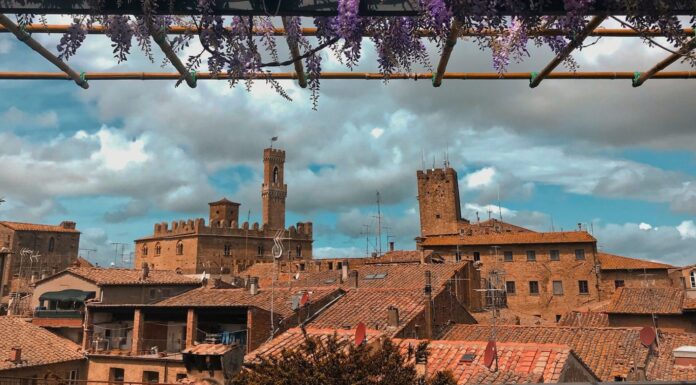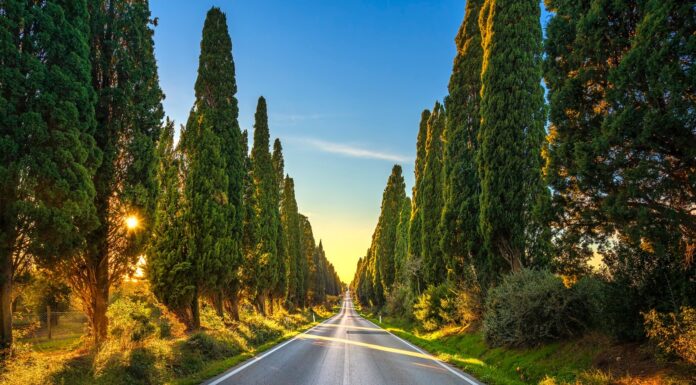Walking through Florence on a daily basis and traveling throughout the country whenever I can, I often marvel at the street art. And I don’t just mean graffiti, of which there is a lot, but I am talking about Italian palaces. Their grandeur, elegance, and style always seems to knock me off my feet. I love meandering through their halls and thinking about how the inhabitants lived hundreds of years ago.
Visiting Italy’s palaces and stepping back in time is just as culturally fulfilling as visiting all of the churches and museums. Italian palaces give visitors an opportunity to obtain some additional exposure to important artifacts and works of art. The architecture of these impressive buildings is an exploration into art in and of itself. Why not spend a few hours imagining how the elites lived hundreds of years ago?
Join us on a journey from northern Italy to southern Italy to learn more about these important buildings, their history, and their enduring significance in Italian culture.
1. Doge’s Palace (Venice)

The Doge’s Palace is likely one of the most recognizable examples of typical Gothic Italian architecture and landmarks for tourists. The building process started in 1340 and was completed in 1442 by Doge Francesco Foscari. It contains many priceless architectural details, including the Golden Staircase, the Great Council Chamber, and the Bridge of Sighs. Tickets are available through their website. A full-price ticket costs €30 but discounts are available.
The walls here tell stories of power, art, and intrigue, with each room offering a new chapter. Imagine wandering through spaces adorned with works by Venetian legends, capturing the spirit and splendor of Venice at its peak. The views from the palace are breathtaking, providing a perfect backdrop for those unforgettable vacation photos. And if you’re curious about the secrets behind these storied halls, consider joining one of the guided tours. They peel back layers of history, revealing fascinating insights into the lives of those who walked these corridors centuries ago.
2. Palazzo Madama (Turin)
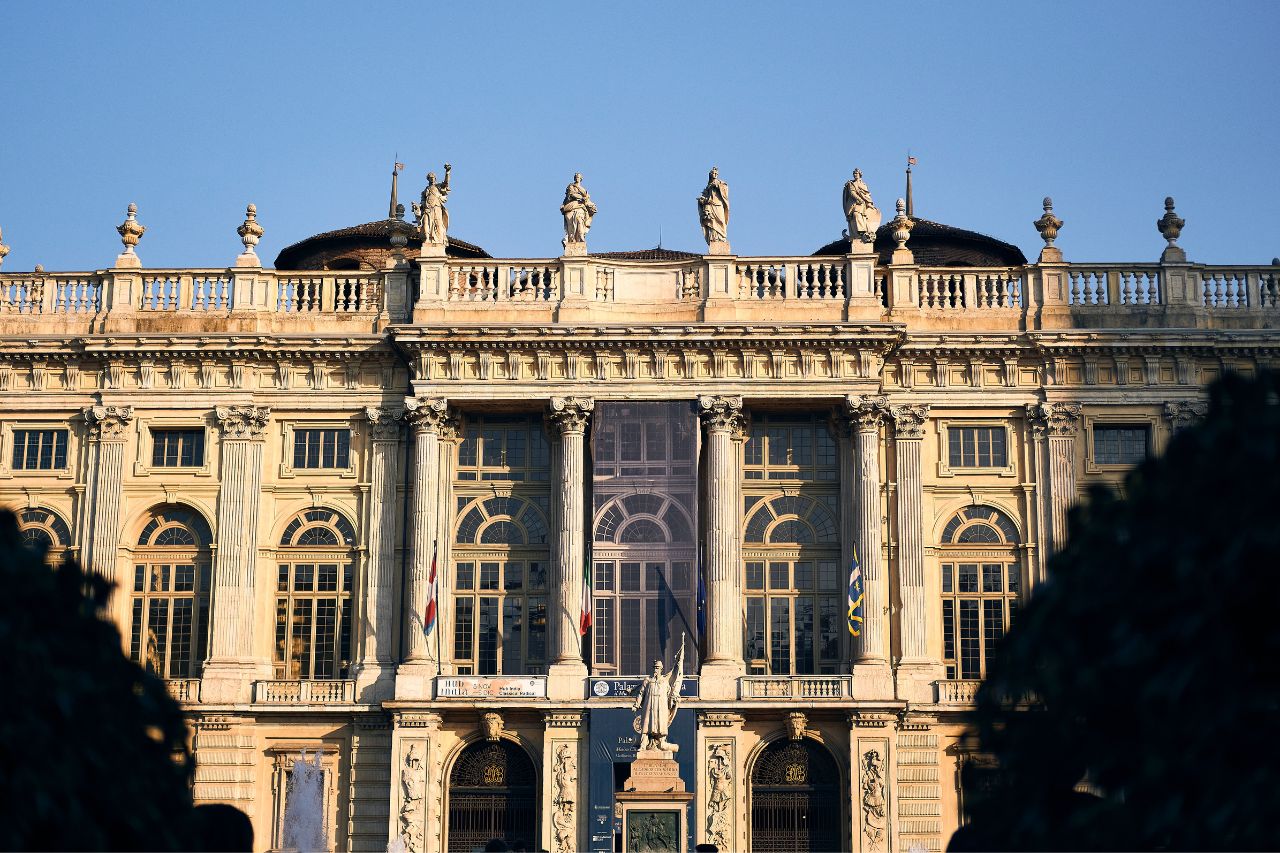
The site of this ancient Italian palace dates back to the first century BC and was part of the Roman walls of the city. In the 14th century, the House of Savoy enlarged it into a castle and Ludovico of Acaja made renovations to include a portico and inner court. Today, it houses the Turin City Museum of Ancient Art, a rare collection of artifacts from various excavations, as well as many pieces from the medieval, Renaissance and Baroque periods. Tickets can be purchased using TicketOne and GetYourGuide, which are €10 each.
As you wander through the corridors of Palazzo Madama, you’re enveloped in the essence of centuries gone by. The museum is a gateway to exploring Italy’s illustrious artistic achievements, with each room offering a unique narrative of historical and cultural evolution. The artifacts and art pieces, ranging from the delicate beauty of Renaissance artwork to the bold expressions of the Baroque era, provide an unparalleled insight into Italy’s artistic legacy. This palace is a journey through time, offering visitors an opportunity to connect with the artistic soul of Italy, enriched by stories of innovation, beauty, and historical transitions.
3. Spinola Palace (Genoa)
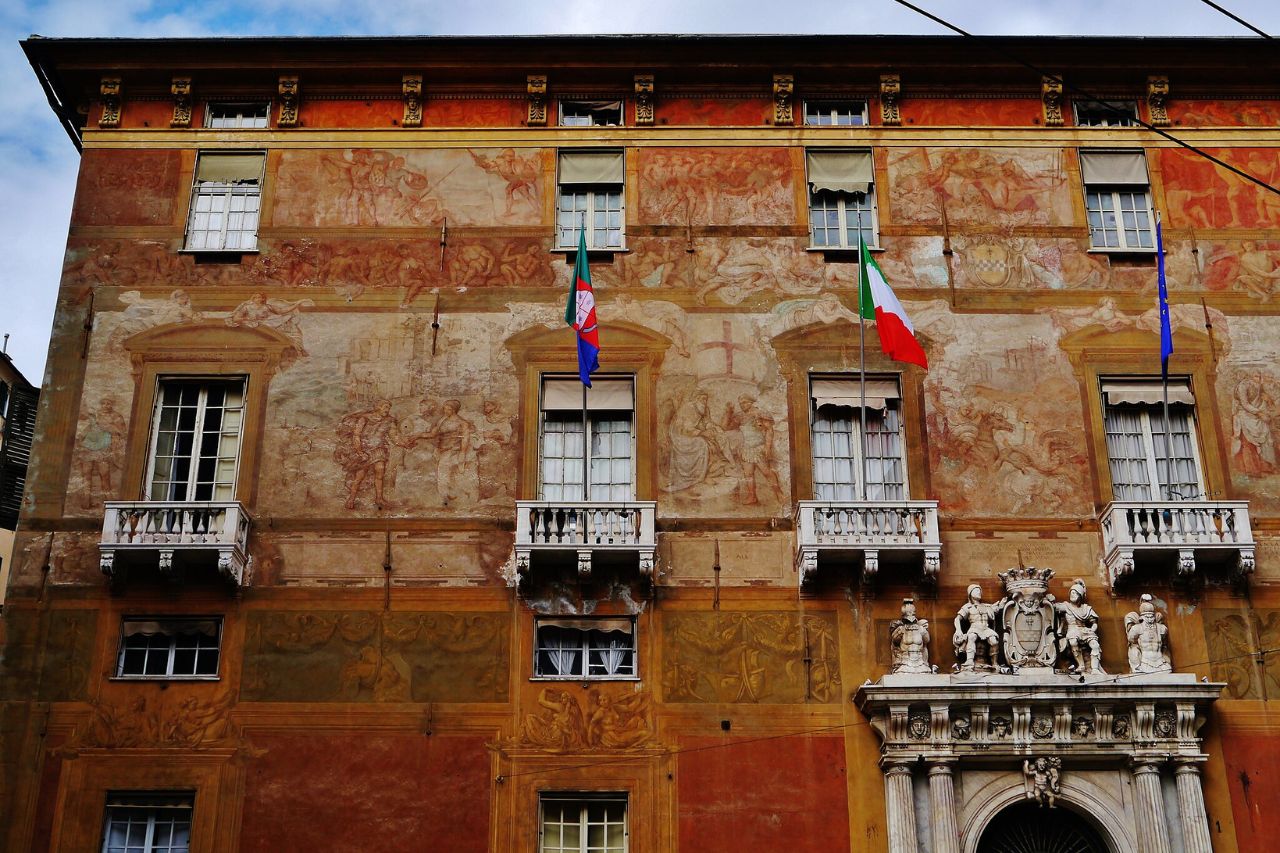
The Palazzo Spinola di Pellicceria in Genoa is one of 163 Palazzi dei Rolli of Genoa, a network of private residences where notable guests of the Republic of Genoa were hosted during state visits. Various masterpieces, including Praying Virgin by Joos van Cleve, Allegory of the Peace and the War by Luca Giordano, and Portrait of a Nun by Bernardo Strozzi, are located here. The entry fee is €11 and tickets can be purchased on their website.
The palace itself, with its opulent rooms and grand architecture, serves as a backdrop to the masterpieces it houses. These works, by renowned artists, not only adorn the walls but also invite visitors to delve deeper into the stories they encapsulate. This experience is further enriched by the palace’s historical significance as part of the Palazzi dei Rolli, highlighting Genoa’s role as a vibrant hub during the Renaissance. A visit here offers an intimate glimpse into the soul of Genoa, making it a must-see for those wishing to experience the depth of Italian art and history.
4. Palazzo Litta (Milan)
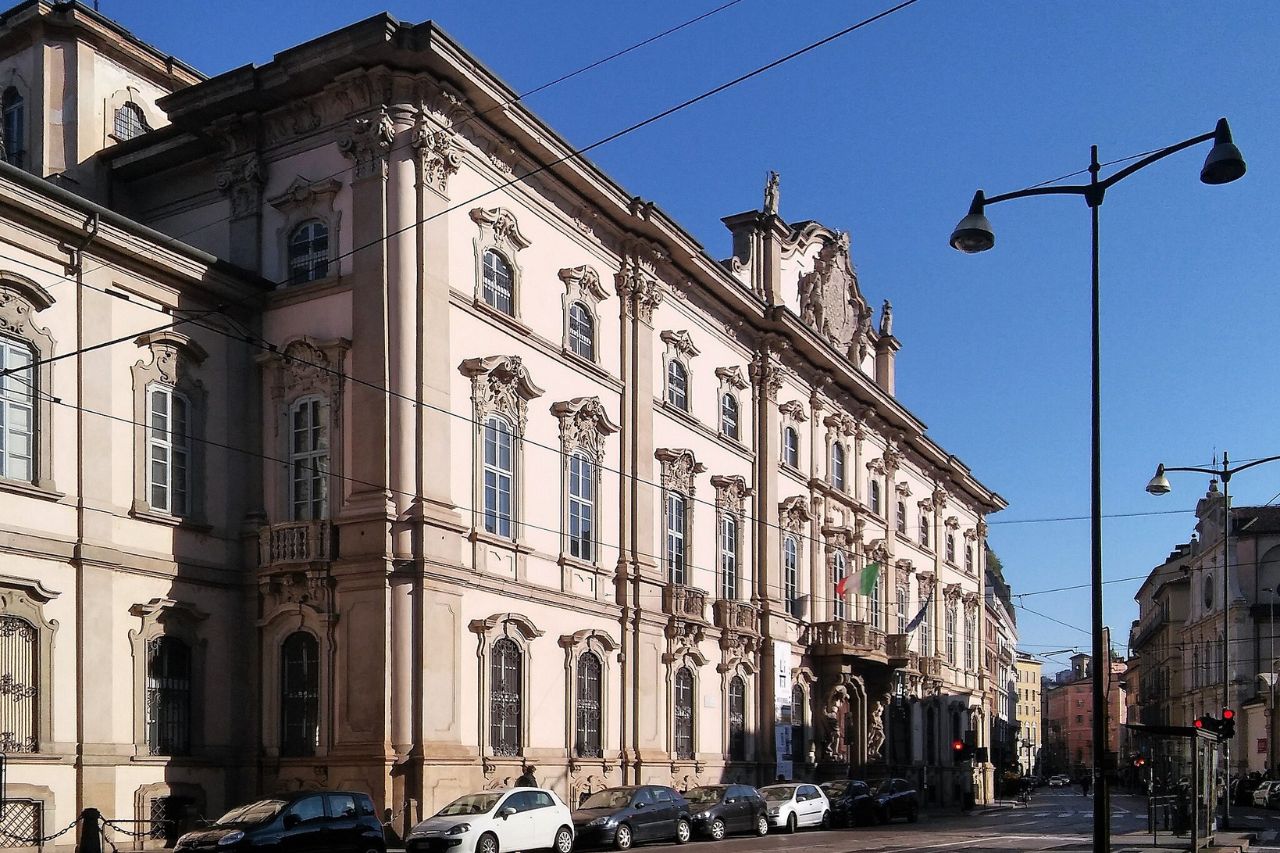
Palazzo Litta, also known as Palazzo Palazzo Arese-Litta, is a shining example of Baroque architecture in Milan. Franceso Maria Richini built Palazzo Litta from 1642-1648 for Count Bartolomo Arese. Count Arese eventually became president of the Senate of Milan in 1660, increasing the importance of the structure. Today, this Italian palace is used as a cultural center and includes exhibition spaces, offices, and a theater.
As you enter Palazzo Litta, you’re greeted by the grandeur of Baroque artistry, with every detail from the façade to the interior exuding opulence and historical significance. The palace not only serves as a testament to Milan’s architectural evolution but also stands as a vibrant cultural hub, bringing together art, history, and community. The exhibition spaces within its walls are a canvas for contemporary artists, offering a unique juxtaposition of the old and the new. Meanwhile, the theater hosts a variety of performances, breathing life into this historic venue.
5. Ducal Palace (Mantua)
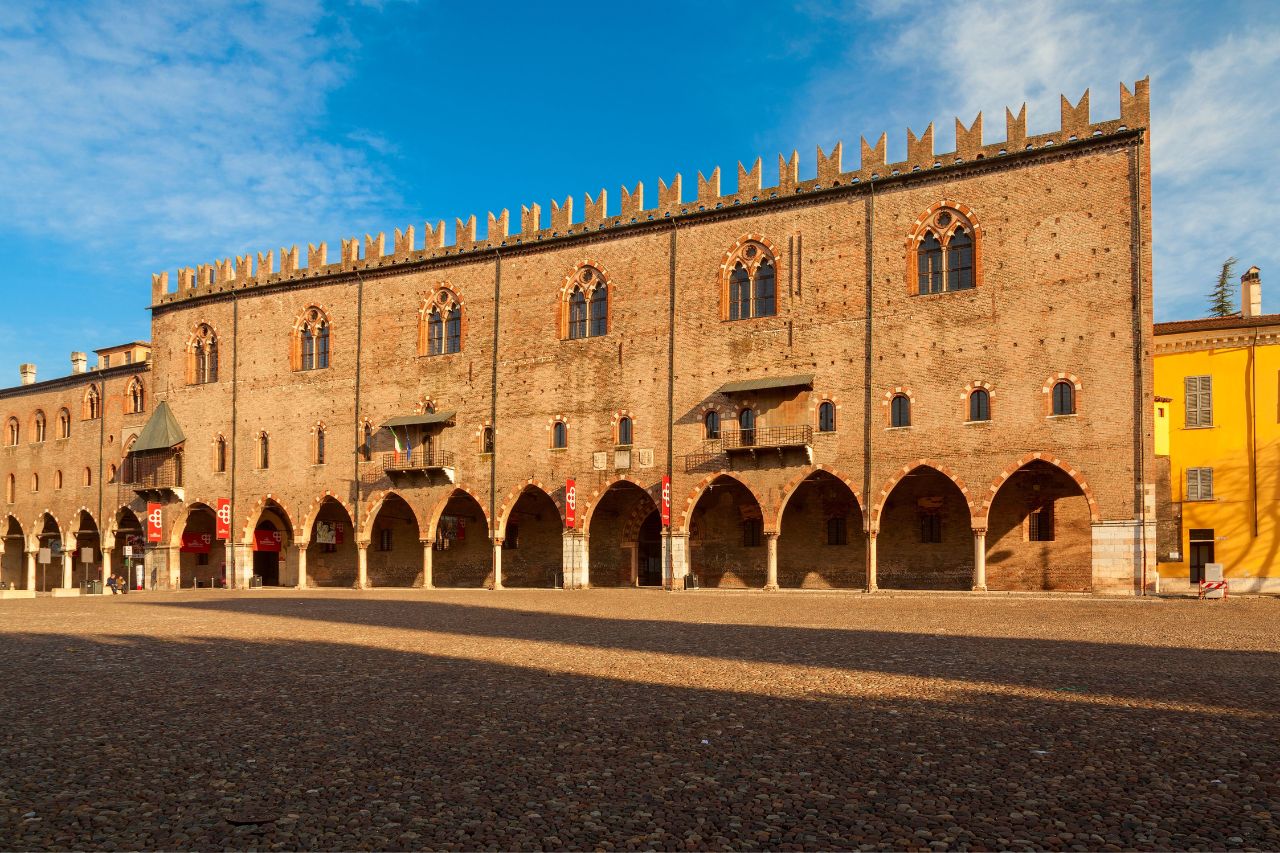
This impressive Italian palace was built between the 14th and 17th centuries for the noble family, Gonzaga, as their royal residence. The complex is composed of 500 rooms and is approximately 34,000 square meters, making it the sixth largest palace in Europe. As if that weren’t impressive enough, it also is famous for housing Mantegna’s frescos in the Camera degli Sposi, or Wedding Room, as well as other architectural details and painted elements. A daily ticket is €15 and can be purchased through the Ducal Palace’s website.
Exploring the Ducal Palace is akin to walking through a grand narrative of Renaissance art and architecture. The sheer scale of the complex with its myriad rooms offers endless discoveries, from lavish state apartments to intimate chambers, each adorned with artistic and architectural marvels. The highlight, Mantegna’s frescoes in the Camera degli Sposi, presents an immersive experience into the artistic genius of the Renaissance, with each detail and color bringing to life the grandeur of the Gonzaga family era.
6. Palazzo Carignano (Turin)
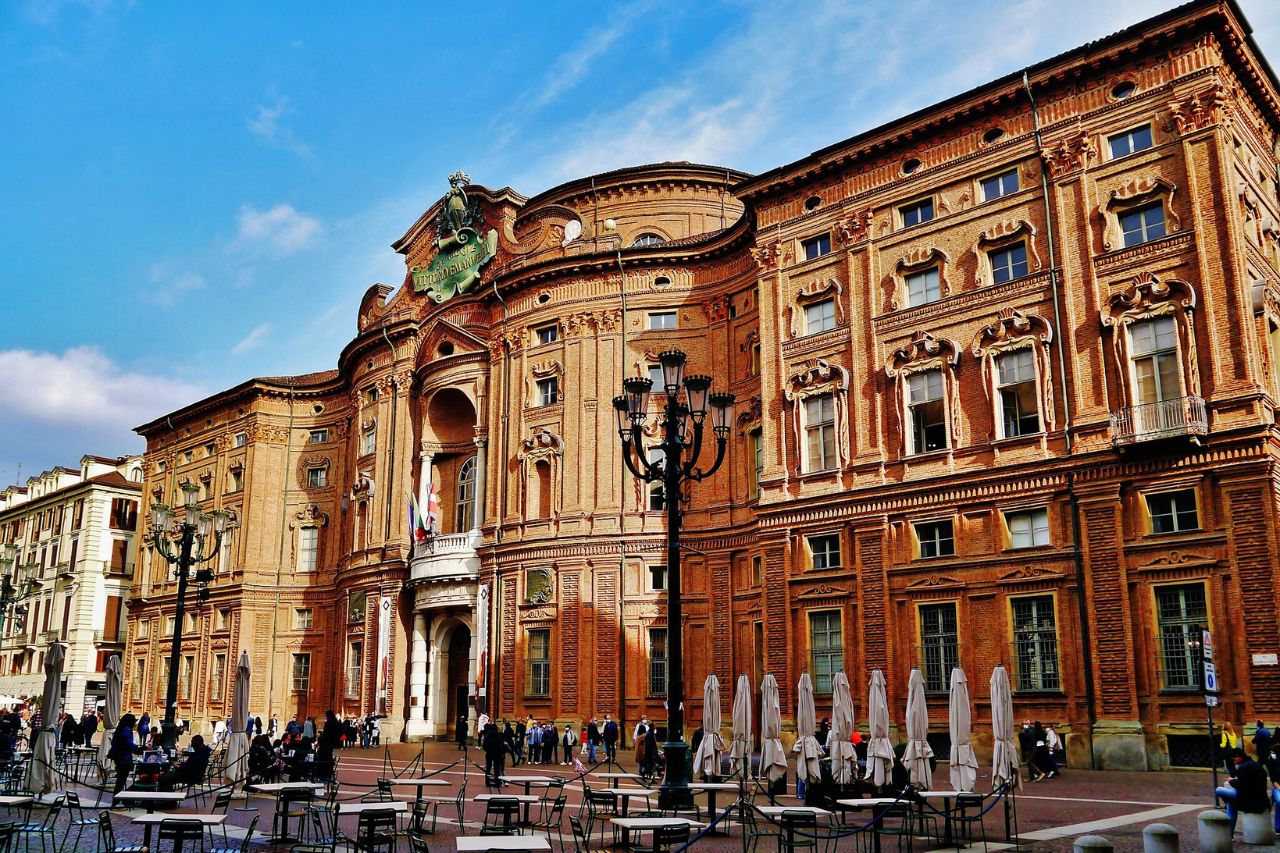
The construction of Palazzo Carignano began in 1679 for Prince Emanuel Philibert of the House of Savoy. Today, it houses the Museum of the Risorgimento, where various uniforms, weapons, flags, printed and written documents (including the Italian national anthem, Il Canto degli Italiani), and various artworks. Depending on the time of year, entrance costs €5 or €6 for adults.
Each artifact within the Museum of the Risorgimento serves as a testament to Italy’s journey towards becoming a unified nation. The museum’s collection invites visitors to delve into the lives of those who fought for Italy’s unity, providing a tangible connection to the country’s past. Moreover, the palazzo’s architecture itself, a masterpiece of Baroque artistry, adds another layer of fascination to your visit. This historic palace offers a unique blend of architectural beauty and educational enrichment, making it an essential stop for anyone interested in exploring the depths of Italy’s historical and cultural evolution.
7. Pitti Palace (Florence)
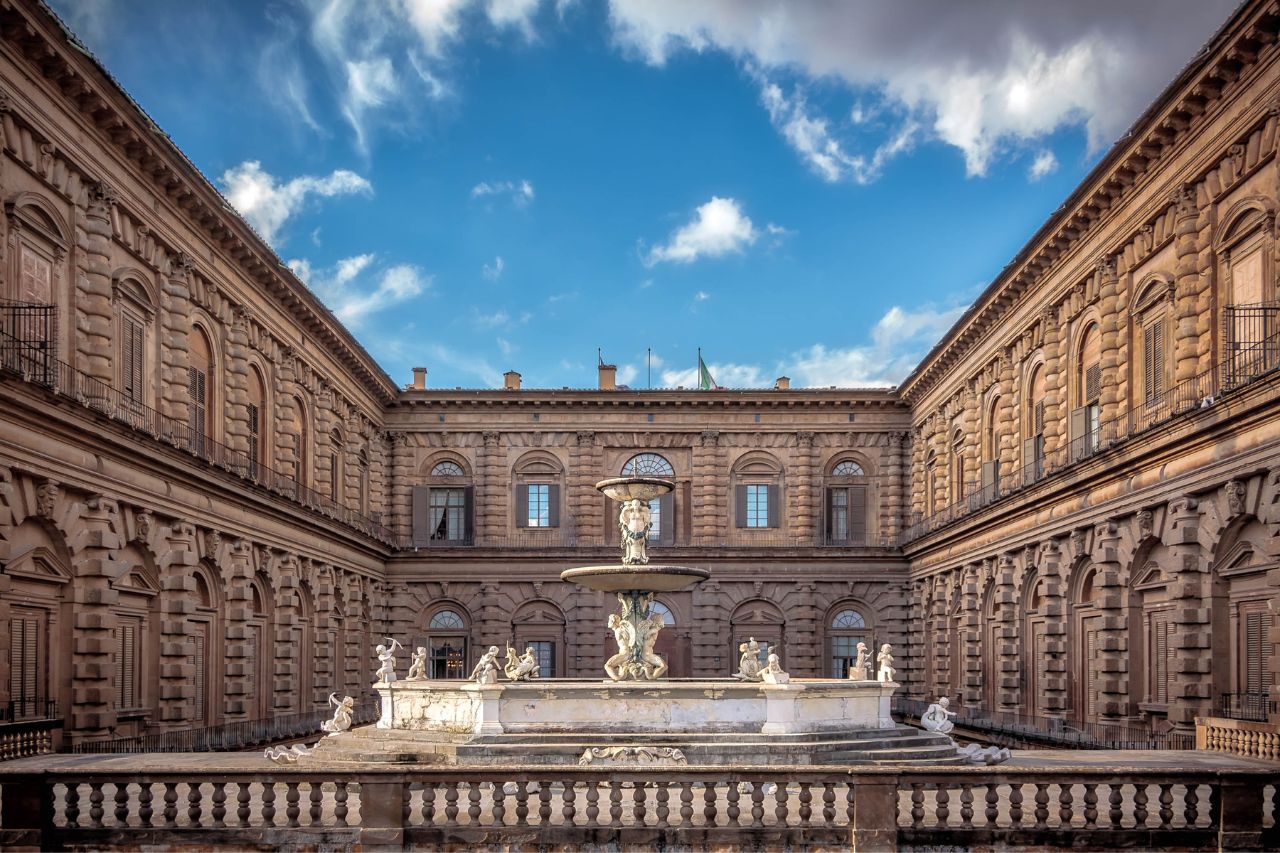
As someone who lives for the opportunity to walk around Florence, I often find myself with my mouth open in complete shock when I pass by the Pitti Palace. Its sheer size – even before setting foot inside – is breathtaking. The core of the palace was built in 1458 and was the original home of Luca Pitti, a Florentine banker. It was bought by the Medici family in 1549. It houses an incredible array of priceless works of art, and the grounds are also spectacular. Entrance to the palace is €17 and tickets are available on the Uffizi’s website. Visitors to the Pitti Palace often add tickets to the adjoining Boboli Gardens for €6 more.
Walking through its halls, you’re tracing the footsteps of the Medici, one of the most influential families in Florence’s history, surrounded by art that has inspired generations. The adjoining Boboli Gardens offer a serene escape, with beautifully landscaped terraces, fountains, and sculptures that extend the artistic experience outdoors. This combination of art, history, and nature makes a visit to the Pitti Palace and Boboli Gardens a comprehensive immersion into the Renaissance spirit that Florence embodies.
Read more: Central Italy Cities – Travel Guide to 17 Fabulous Gems
8. Palazzo Ducale (Lucca)

This large Italian palace used to occupy one fifth of the city until it was destroyed by the people of Lucca in 1370. Although it was restored and used as a residence by Paolo Guinigi in 1401; however, after his fall in 1429 it was again dismantled. In its center, it features a statue of Lucchese lawyer Francesco Carrara. The palace itself is home to many statues. These days the palace hosts many special events and shows.
The Palazzo Ducale’s turbulent history reflects the changing fortunes of Lucca itself, a city with a rich tapestry of history and culture. The restoration efforts and the adaptive reuse of the palace as a venue for events and shows speak to the resilience and creativity of the Lucchese people. Walking through its halls, visitors can sense the layers of history, from the grandeur of its past residents to the communal spirit that led to its temporary downfall. The statue of Francesco Carrara stands as a reminder of the city’s historical significance and its contribution to legal scholarship.
9. Riccardi Medici Palace (Florence)
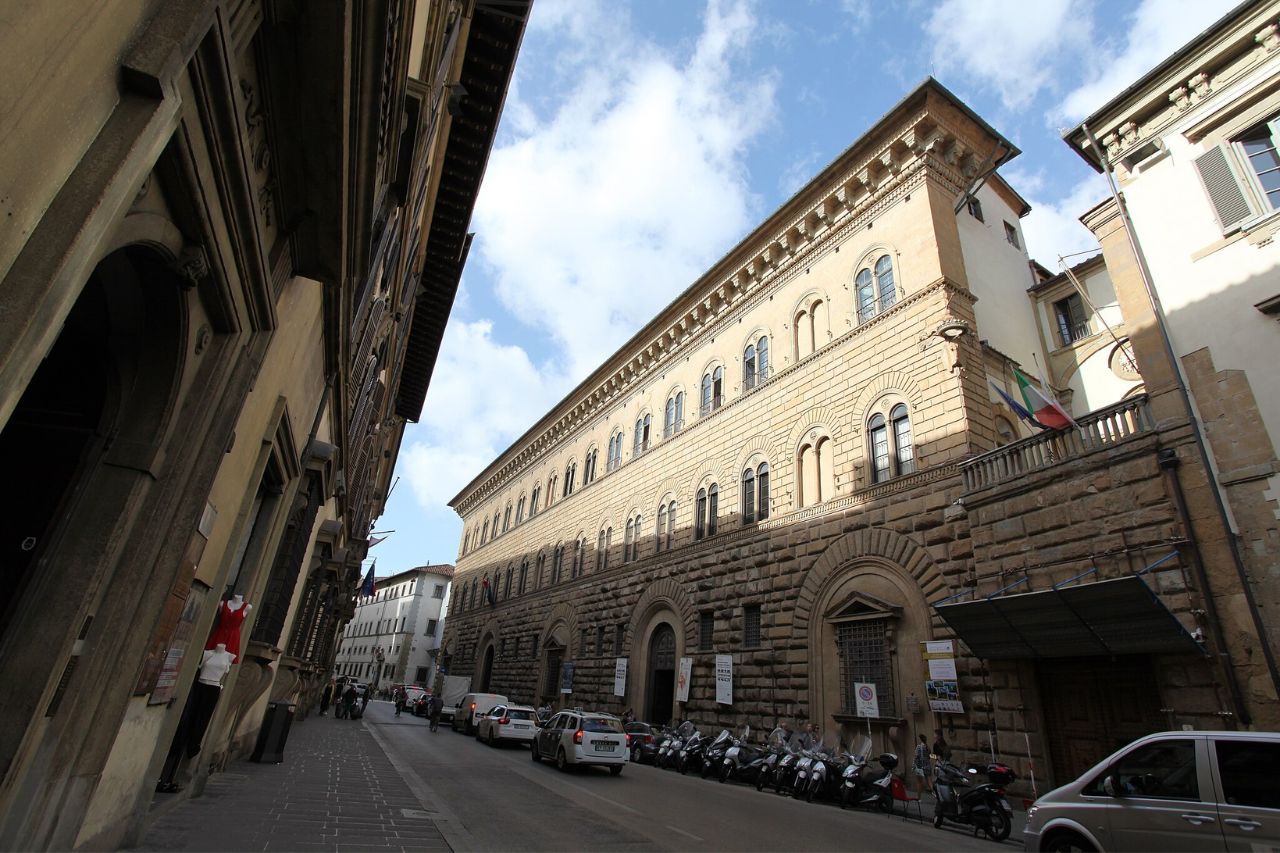
Built between 1444 and 1484, the Riccardi Medici Palace was built for Cosimo Medici, head of the Medici banking family. The ticket includes access to other areas, including the Hall of Mirrors, marble museum, and exhibitions in progress. Tickets cost €10 and are available for purchase on the website.
Its architecture and interiors, including the renowned Hall of Mirrors, reflect the family’s wealth and their patronage of the arts. The marble museum within its walls showcases the Medici family’s fascination with both the ancient and the contemporary art of their time, offering visitors a glimpse into the artistic trends that shaped the Renaissance. The palace’s ongoing exhibitions ensure that, in addition to its historical significance, it remains a vital part of Florence’s cultural scene today. A visit to the Riccardi Medici Palace is not just a journey into the past; it’s an exploration of the enduring legacy of one of Italy’s most influential families and their impact on art and culture.
10. Chigi Palace (Rome)
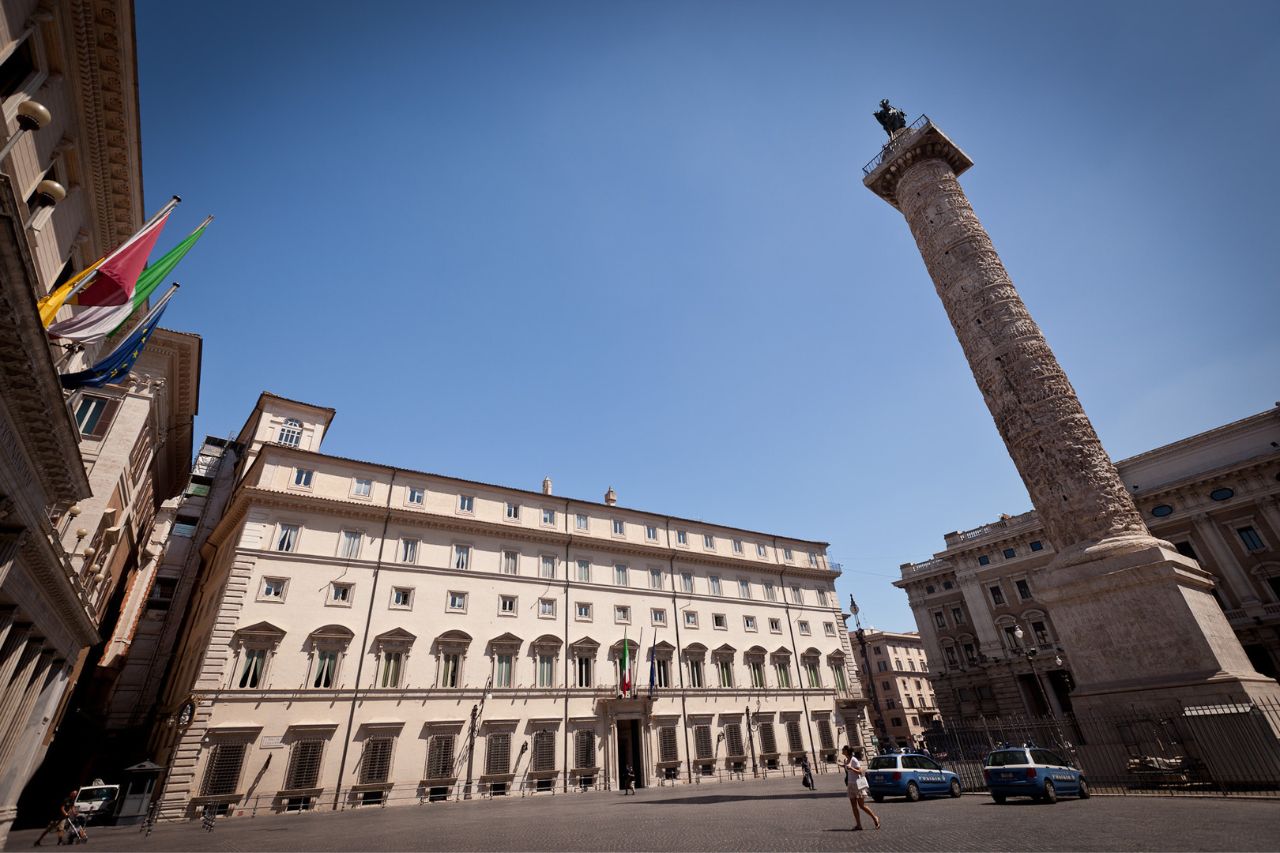
Today, Chigi Palace in Rome is the home to the Italian prime minister. But, it has more than three centuries of history – in years past it was utilized as a noble residence. Building this Italian palace began in 1562 by Giacomo della Porta, and over time has gone through various stages of renovations. The Library Hall holds an enormous collection of books from cardinal Flavio Chigi, as well as thousands of valuable manuscripts. Access to the palace is limited for those who are interested; information is available on the Chigi Palace website.
The Library Hall, with its vast collection of books and manuscripts, offers a unique insight into the intellectual pursuits and legacies of the Chigi family and their era. This collection is a treasure trove for scholars and history enthusiasts alike, providing a rare glimpse into the past. While access to the palace may be restricted, its role in Italian history and the opportunity it provides for historical exploration make it a fascinating aspect of Rome’s cultural landscape. The palace’s evolution from a noble residence to the seat of the prime minister mirrors the changing dynamics of Italian society and governance, making it a symbol of continuity amidst change.
11. Palazzo Barberini (Rome)
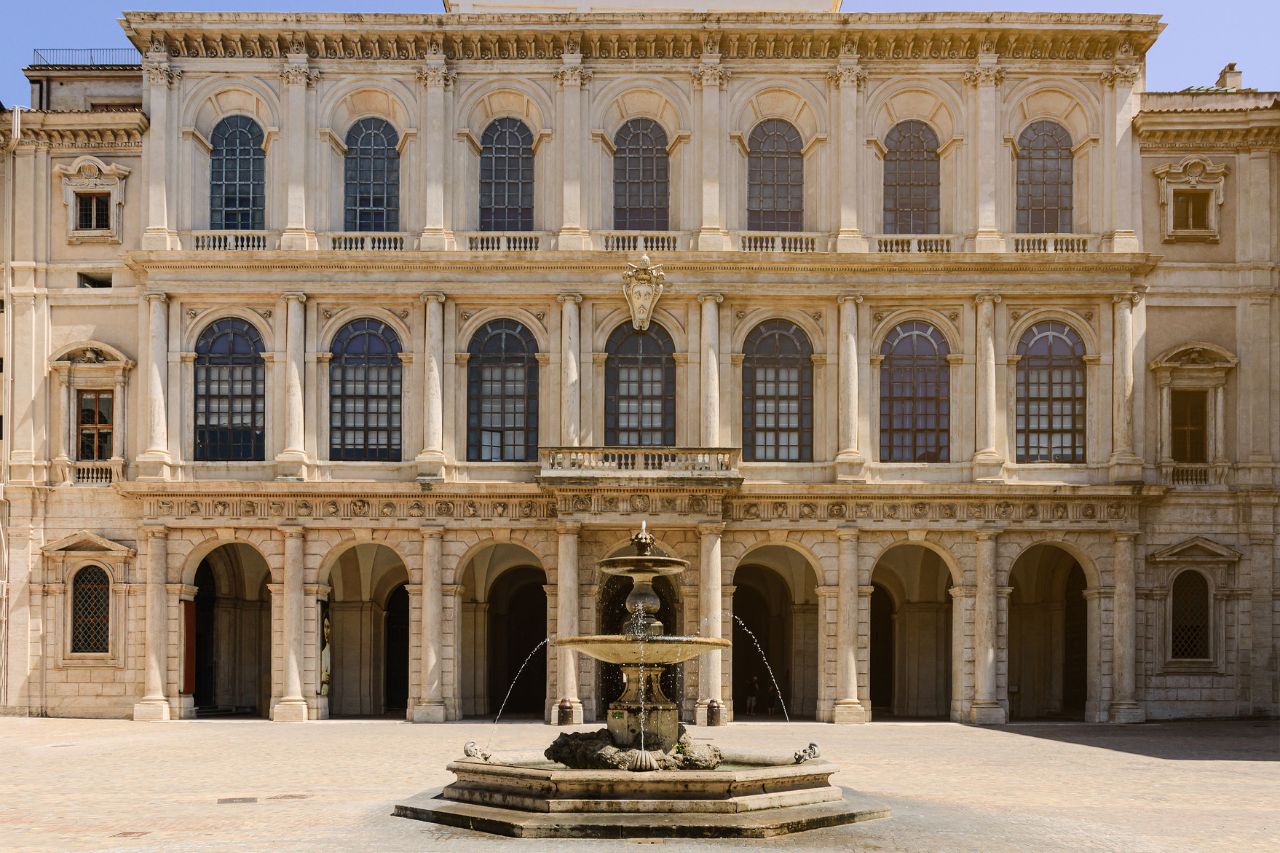
In 1645, Matteo Barberini bought the site where this Italian palace stands from the Sforza family. Matteo Barberini would eventually become Pope Urban VIII and the site of this impressive white palace would eventually become a shining example of Italian architecture. Today it houses the Galleria Internazionale d’Arte Antica, or International Gallery of Antique Art, the main collection of older paintings in Rome. Tickets to enter the palace and the gallery are separate and each costs €12. Purchase tickets on the palace’s website.
Hosting the Galleria Internazionale d’Arte Antica, it presents a vast array of masterpieces that span the history of art, offering visitors an unparalleled journey through time. The gallery’s collection, featuring works from the early Renaissance to the late Baroque periods, highlights the depth and diversity of artistic expression. Beyond its art, the architecture of Palazzo Barberini itself is a masterpiece, reflecting the grandeur and ambition of the Baroque era. Visiting this palace is an opportunity to immerse oneself in the rich tapestry of Italian history, art, and architecture, making it a must-see for anyone wishing to explore the cultural heritage of Rome.
12. Ducal Palace (Urbino)
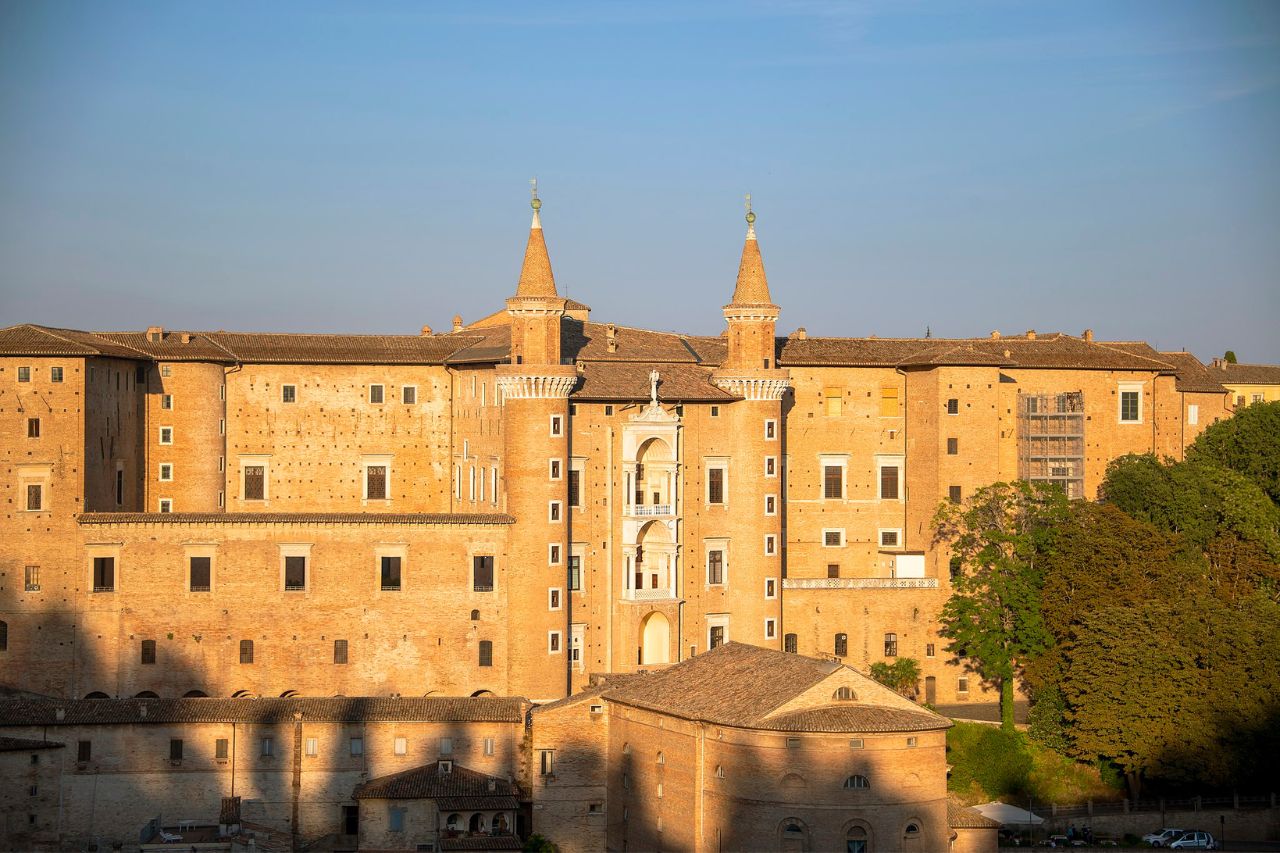
The Ducal Palace is one of the main monuments of the city of Urbino and an impressive example of Italian Renaissance art and architecture. It is the seat of The National Gallery of Le Marche, which showcases some of the most important Renaissance art in the world. Entrance is €10 and tickets are available online.
Visiting the Ducal Palace in Urbino offers an extraordinary opportunity to experience the pinnacle of Renaissance art and architectural beauty. The National Gallery of Le Marche, housed within its walls, contains masterpieces by renowned artists, allowing visitors to delve deep into the rich tapestry of Renaissance creativity and thought. The palace itself, with its elegant façades and harmonious proportions, stands as a testament to the ingenuity and vision of the Renaissance architects and the sophisticated court culture of Urbino. This integration of art and architecture provides a comprehensive insight into the period’s cultural achievements, making a visit to the Ducal Palace a must for enthusiasts of history, art, and the Renaissance era.
13. Royal Palace of Caserta (Caserta)
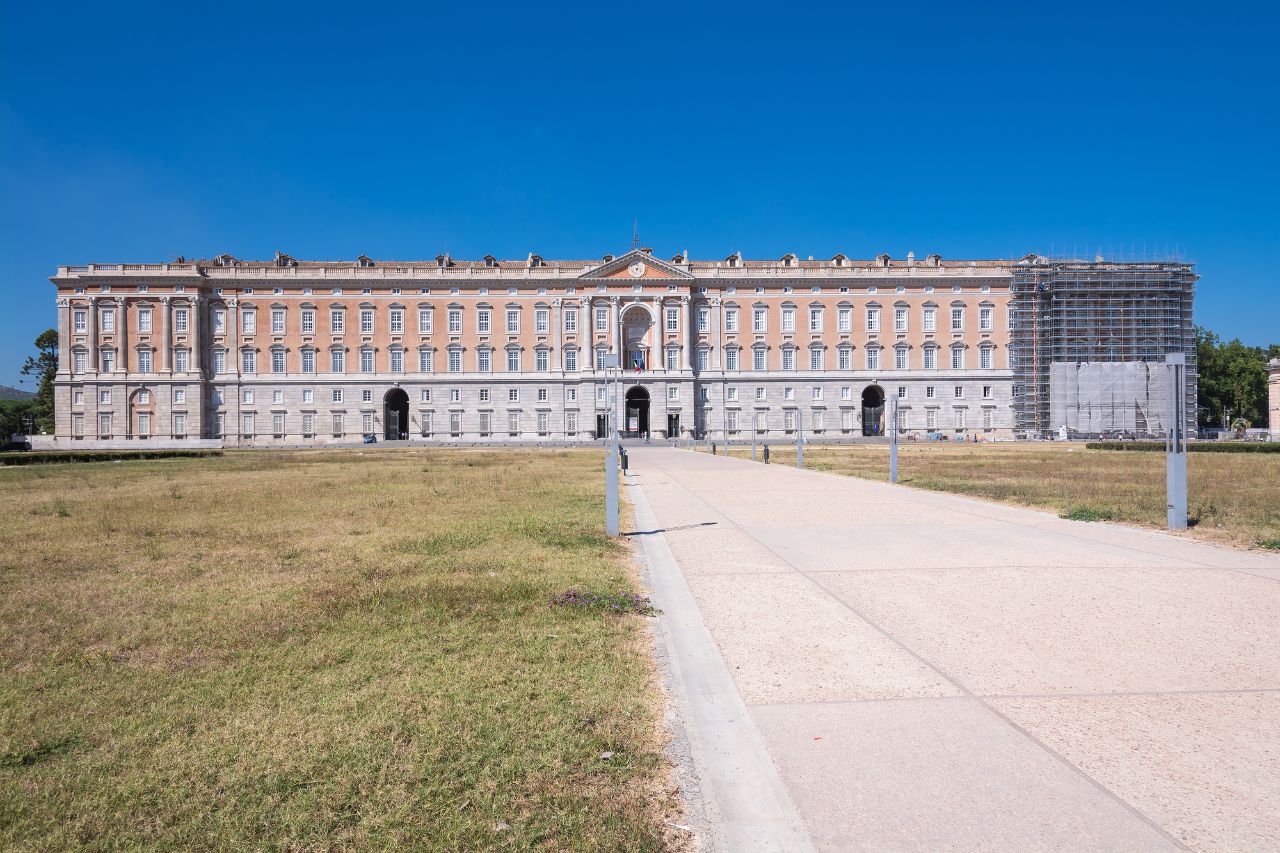
Welcome to the Italian version of Versailles. The Royal Palace of Caserta was constructed for King Charles VII of Naples starting in 1751. It is the largest former royal residence in the world, covering more than 47,000 square meters. As if that wasn’t enough, there is an enormous park on the grounds that has five fountains throughout. Tickets are €15 and available through their site.
The palace’s architecture is a testament to the ambition and vision of the Bourbon kings of Naples, showcasing a blend of Italian Baroque and Neoclassicism. The vast park, adorned with elaborate fountains and waterfalls, offers visitors a serene escape into nature, designed to impress and entertain guests of the royal court. Each fountain tells a story, from mythological scenes to allegories of the ancient world, creating a walking journey through art and history.
14. Royal Palace of Naples (Naples)
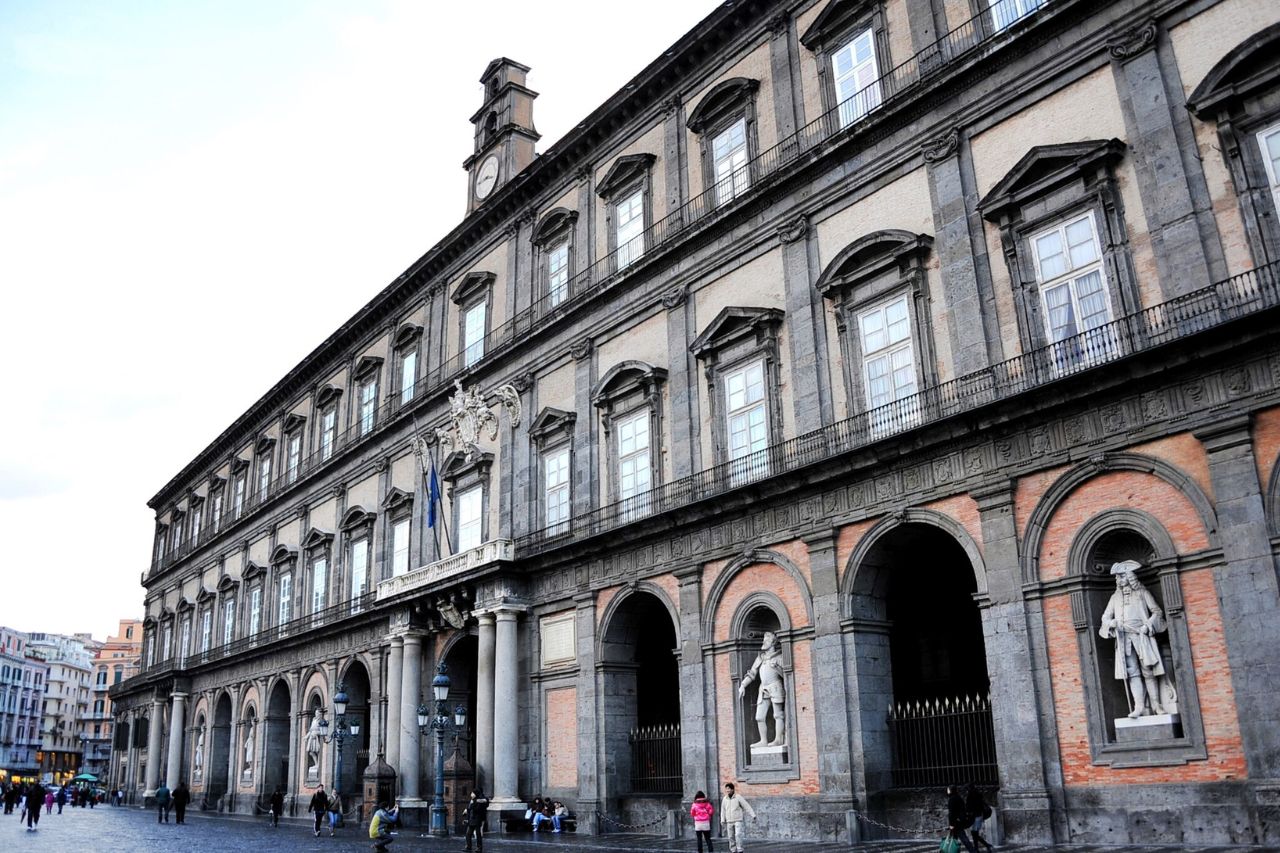
The Royal Palace of Naples serves as a museum and tourist destination. In years past, it was the royal residence of the Bourbons. The facade was completed in 1616 and the interior was frescoed in 1620. The outside is particularly known for its sculptures, which depict former kings of Naples. Tickets for select attractions are available on their site.
As a museum, the Royal Palace of Naples offers a deep dive into the history and culture of Naples and the Bourbon dynasty. The meticulously frescoed interiors provide a visual feast, transporting visitors back to the opulence and artistry of the 17th century. The palace’s exterior sculptures serve as a homage to the city’s rulers, each telling a piece of Naples’ storied past. A visit to the Royal Palace it’s an immersive experience into the heart of Neapolitan heritage, offering a unique blend of art, history, and architectural beauty. This majestic palace, with its rich history as a royal residence and its current role as a cultural repository, stands as a testament to the enduring legacy of Naples as a center of art and culture.
15. Norman Palace (Palermo)
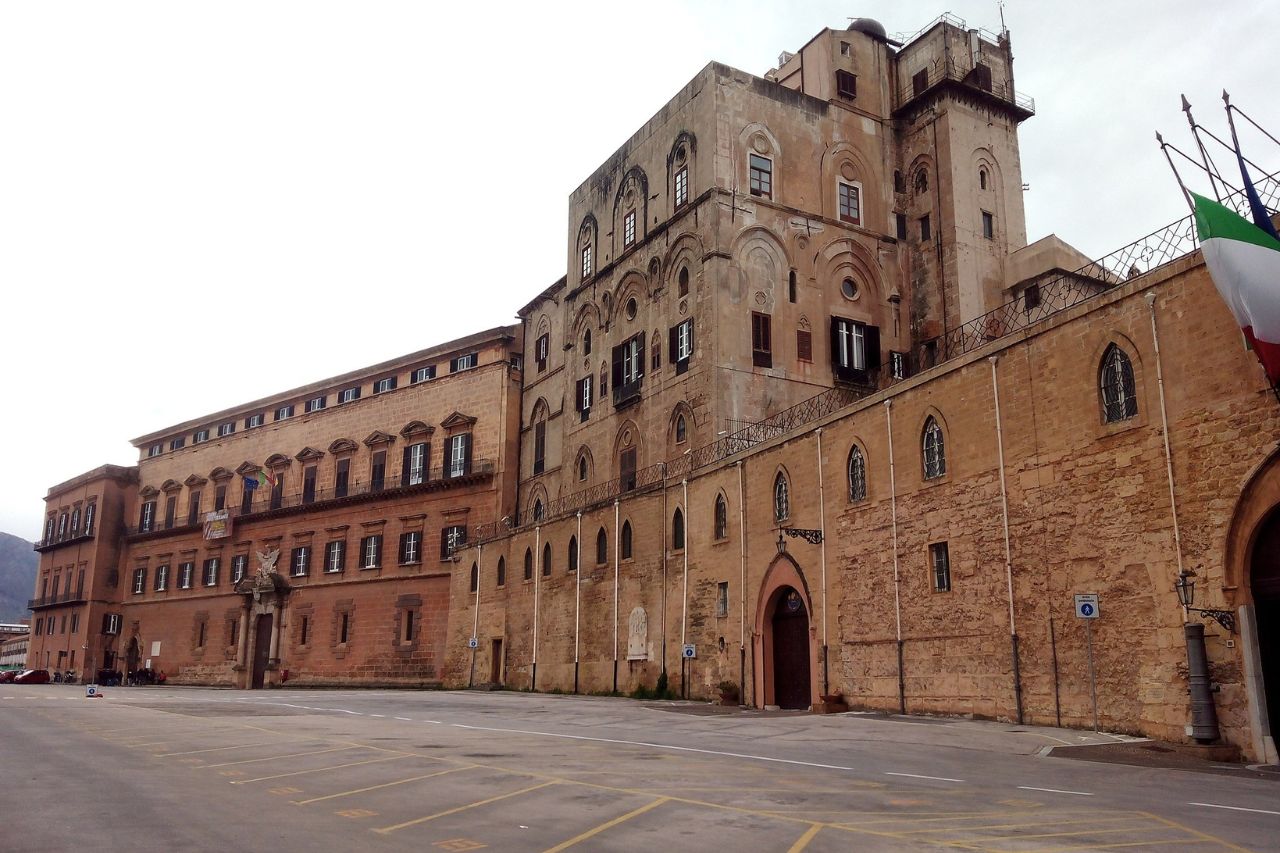
This stunning palace in Italy is also called the Royal Palace of Palermo. Built in 1072, it’s the oldest royal residence in Europe. At one time it was the seat of the Kings of Sicily. Visit to experience the Cappella Palatina, considered to be the best example of the Norman-Arab-Byzantine style. You can purchase tickets for €15 through their official site, just click “Biglietteria Online.”
The Cappella Palatina, with its breathtaking mosaics and intricate inlays, showcases the harmonious blend of different artistic traditions that Sicily has become known for. Beyond the chapel, the palace’s rooms and halls tell the story of a rich past, from its origins as a Norman stronghold to its role as a center of power in the Mediterranean. Visiting the Norman Palace is an opportunity to immerse yourself in the layered history of Palermo, where every corner and corridor reveals centuries of art, power, and cultural exchange.
16. Palazzo Corvaja (Taormina)
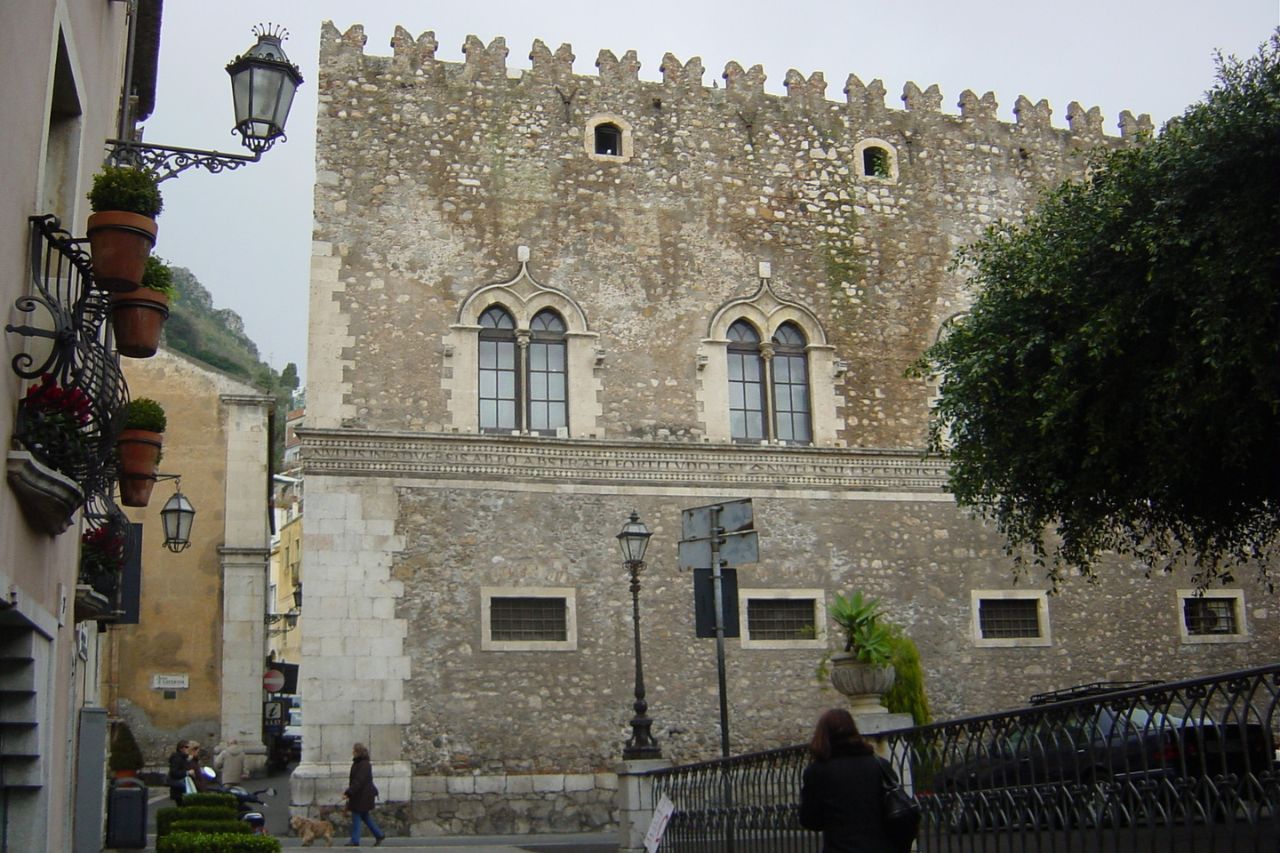
This late 14th-century castle is located in Sicily and was named after one of the most important families in Sicily. Today, it is used as an exhibition center for the tourism office.
Palazzo Corvaja’s rich history and architectural beauty make it a fascinating destination for visitors to Taormina. As an exhibition center, it offers insights into Sicilian culture and history, providing a unique backdrop for the tourism office’s displays. The palazzo itself, with its blend of Arab, Norman, and Gothic architectural elements, stands as a testament to the diverse cultural influences that have shaped Sicily over the centuries. This historical edifice not only offers a glimpse into the past but also actively contributes to the cultural and touristic landscape of Taormina, making it a must-visit for anyone interested in the island’s heritage and the story of the Corvaja family’s significant role in Sicilian history.
17. Palace of the Princes of Belmonte (Santa Maria di Castellabate)
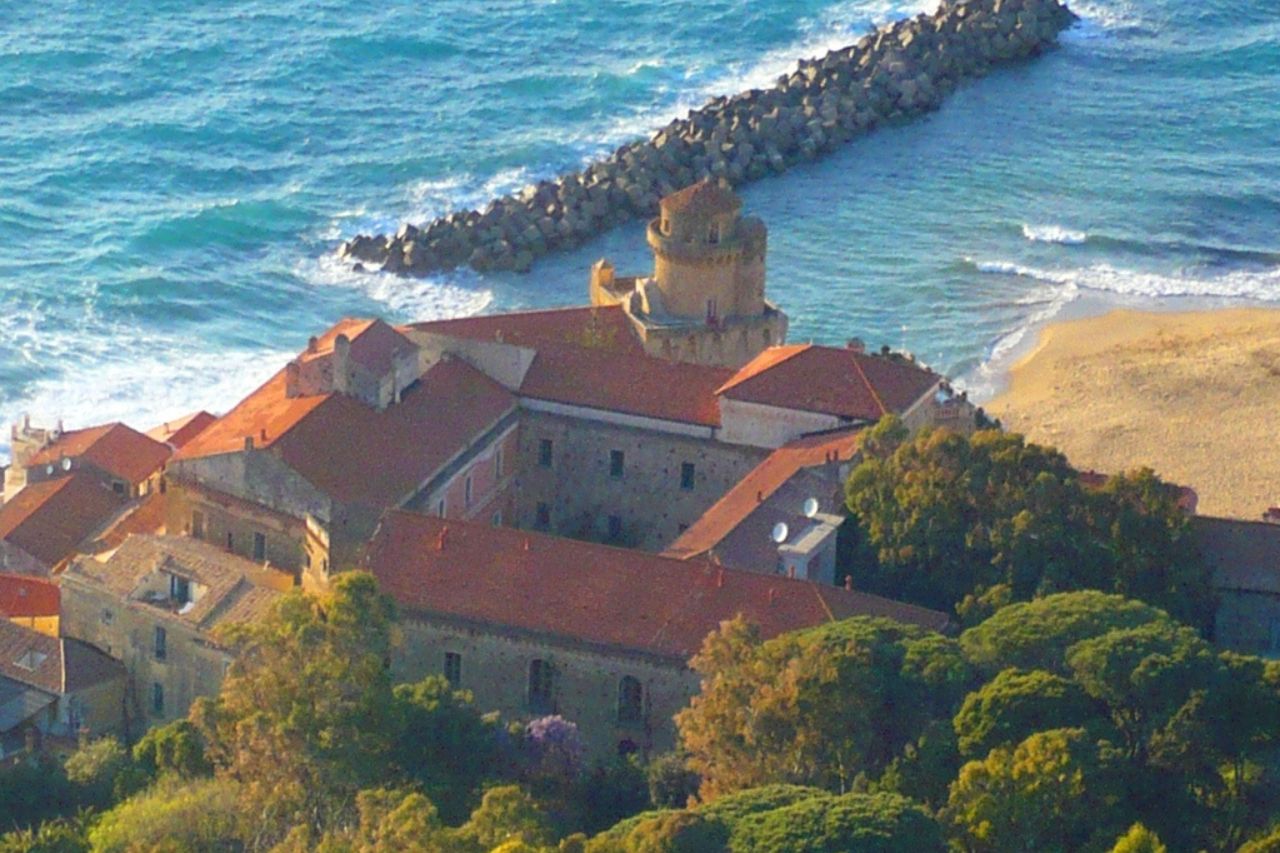
Castellabate is located just south of Italy’s infamous Amalfi Coast and is also a UNESCO World Heritage Site. Here you will find the Palazzo Belmonte, a unique, 17th-century historic residence right by the sea. Book a few nights here and you will be transported in time.
This palatial residence, once home to Italian nobility, now opens its doors to those seeking to immerse themselves in the splendor of Italian history and culture. Surrounded by lush gardens and overlooking the azure sea, guests are invited to explore the elegantly preserved rooms, each echoing the tales of its illustrious past. Here, history enthusiasts and romantics alike can bask in the timeless charm that Palazzo Belmonte and the village of Castellabate have to offer, making every moment spent a precious memory.
18. Palazzo San Giacomo (Naples)
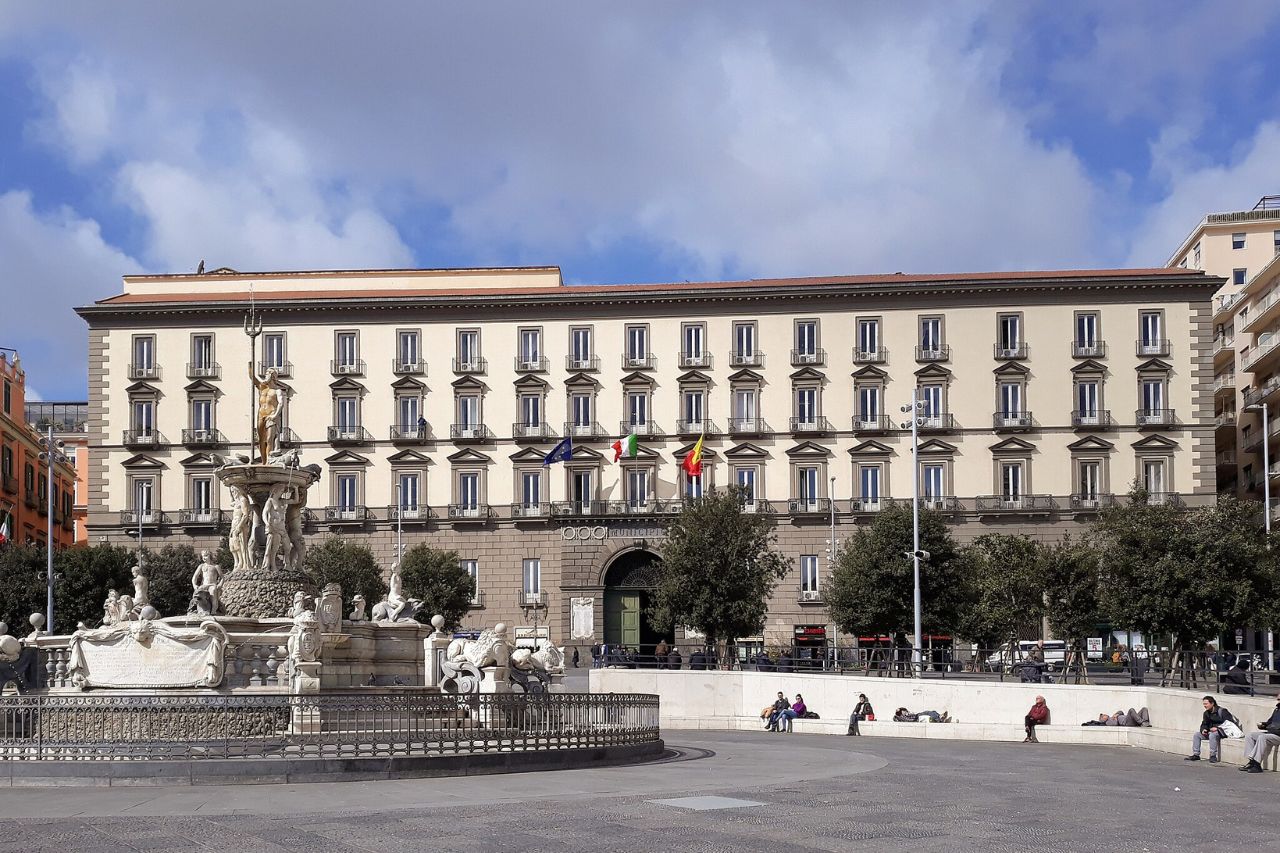
Palazzo San Giacomo is an important building in the history of Naples. Today, it serves as city hall and houses the mayor and the offices of the municipality of Naples. In 1816 King Ferdinand of the Two Sicilies commissioned the building of the palace to serve as a centralized location for the government. People who would like to visit the palazzo can submit requests at the website below, as it is open for various exhibits and guided tours.
This grand edifice not only showcases Naples’ rich history but also functions as a vibrant center for civic life. Visitors can immerse themselves in the architectural beauty and historical significance of Palazzo San Giacomo, exploring the intricacies of its design and the pivotal role it has played in Neapolitan governance over the centuries. The opportunity to walk through its halls is a unique experience, offering insights into the cultural and political heritage that shapes Naples today.
19. The Royal Venaria (Venaria)
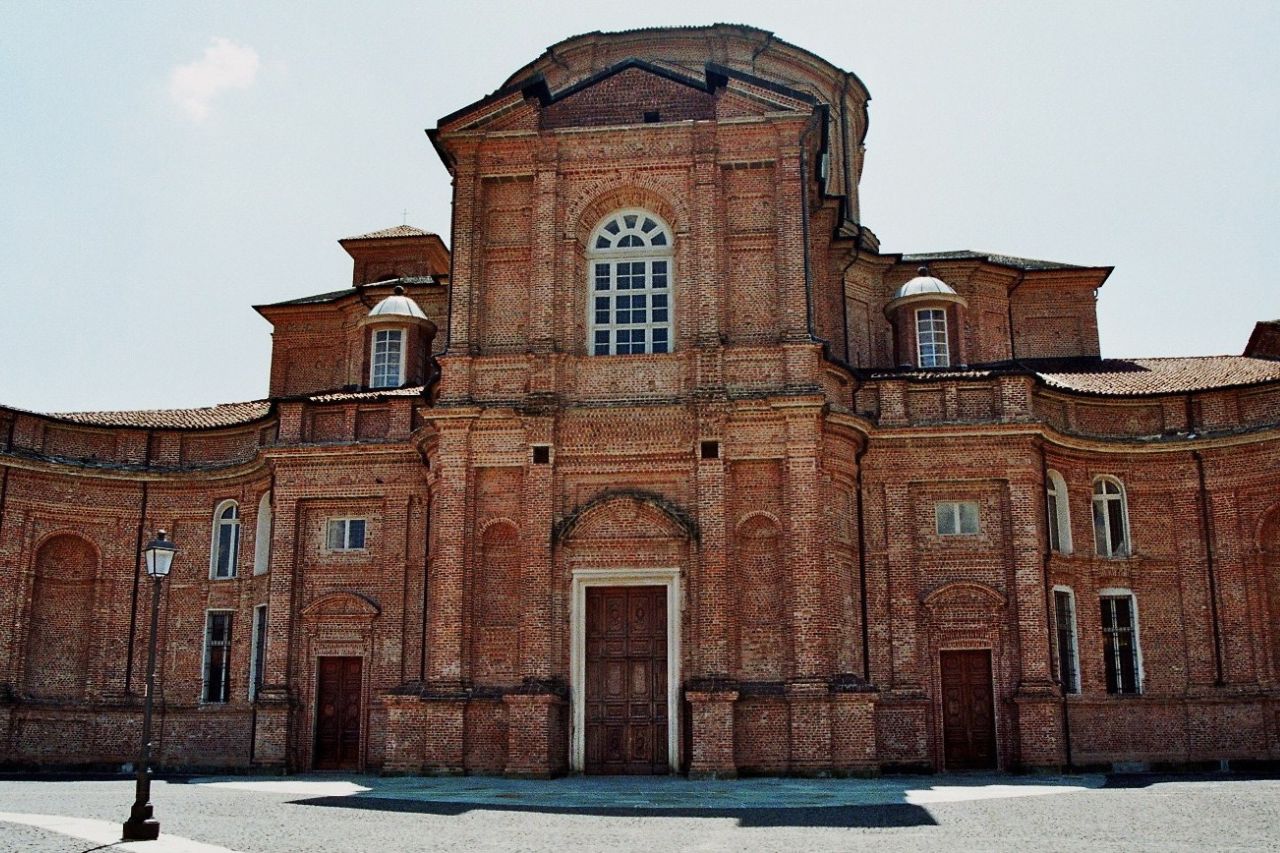
Travel north to Turin and you will find The Palace of Venaria. This stunning Italian palace is another former royal residence of the Royal House of Savoy. It was built in 1675 and was commissioned by Charles Emanuel II. Marvel at the architectural details or simply explore the expansive grounds. Tickets are available online and vary in price, depending on your desired experience.
The palace’s meticulously restored rooms and gardens invite visitors to step back in time and experience the grandeur of Italian royalty, while the surrounding park, a UNESCO World Heritage site, provides a perfect setting for leisurely walks and nature exploration. This combination of historical architecture, art, and natural beauty makes The Royal Venaria a must-visit destination, offering something for everyone to appreciate.
20. Palazzo Regio-Cagliari (Cagliari)
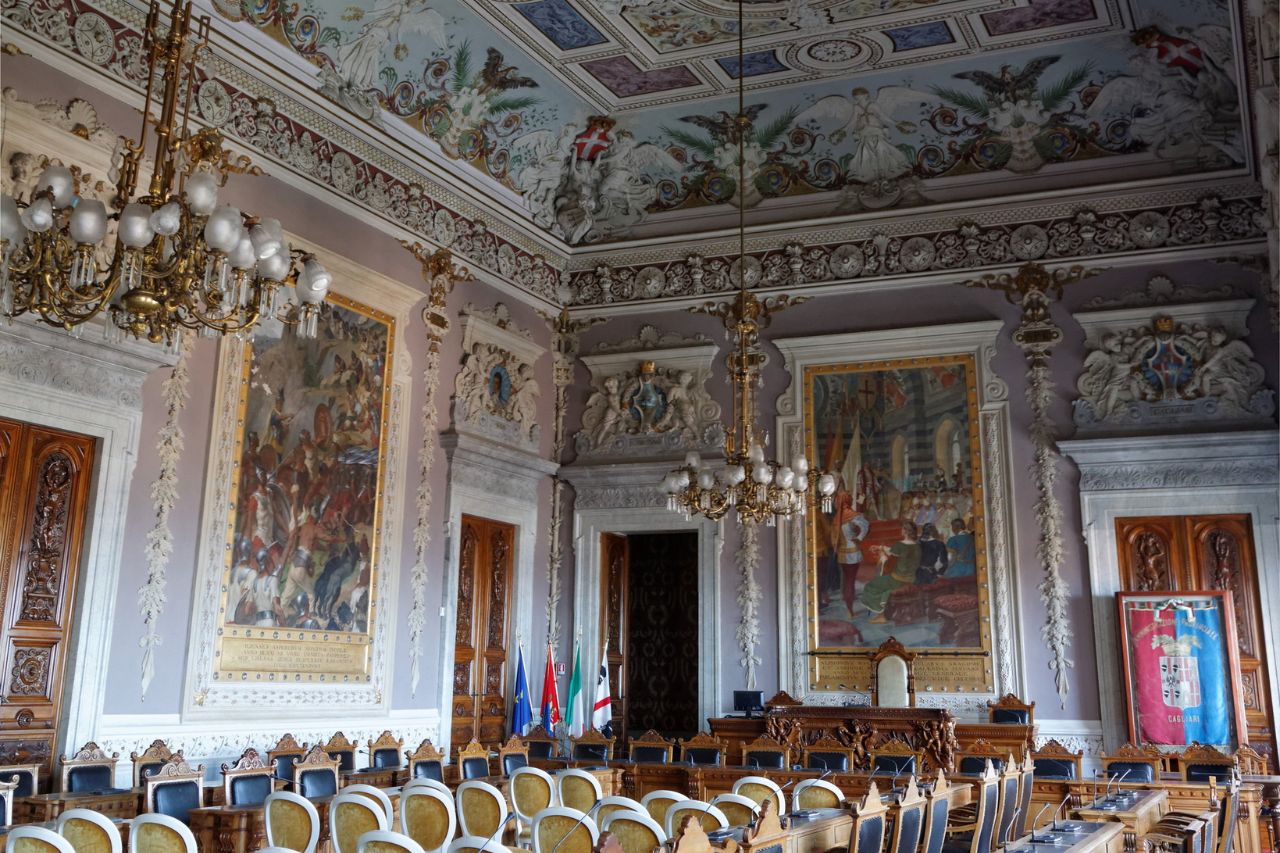
When they say something is built for a king, they really are talking about this Italian palace. Palazzo Regio, also known as Viceregio, used to be the residence of the king of Sardinia. It was built in the 14th century and is located in the Castello district, which in Italian means “castle” – very appropriate. Visit the palace to marvel the stunning interior as well as frescoes and other artwork. Purchase tickets on the palace’s website for €5.
Beyond its majestic walls and royal past, the Palazzo Regio offers visitors a unique glimpse into the artistic and cultural traditions of the island. Its location in the historic Castello district further enhances its allure, inviting explorers to step back in time amidst ancient streets and breathtaking views of Cagliari. An excursion to Palazzo Regio is more than a visit; it’s an experience that encapsulates the soul of Sardinia.
21. Palazzo Vecchio (Florence)
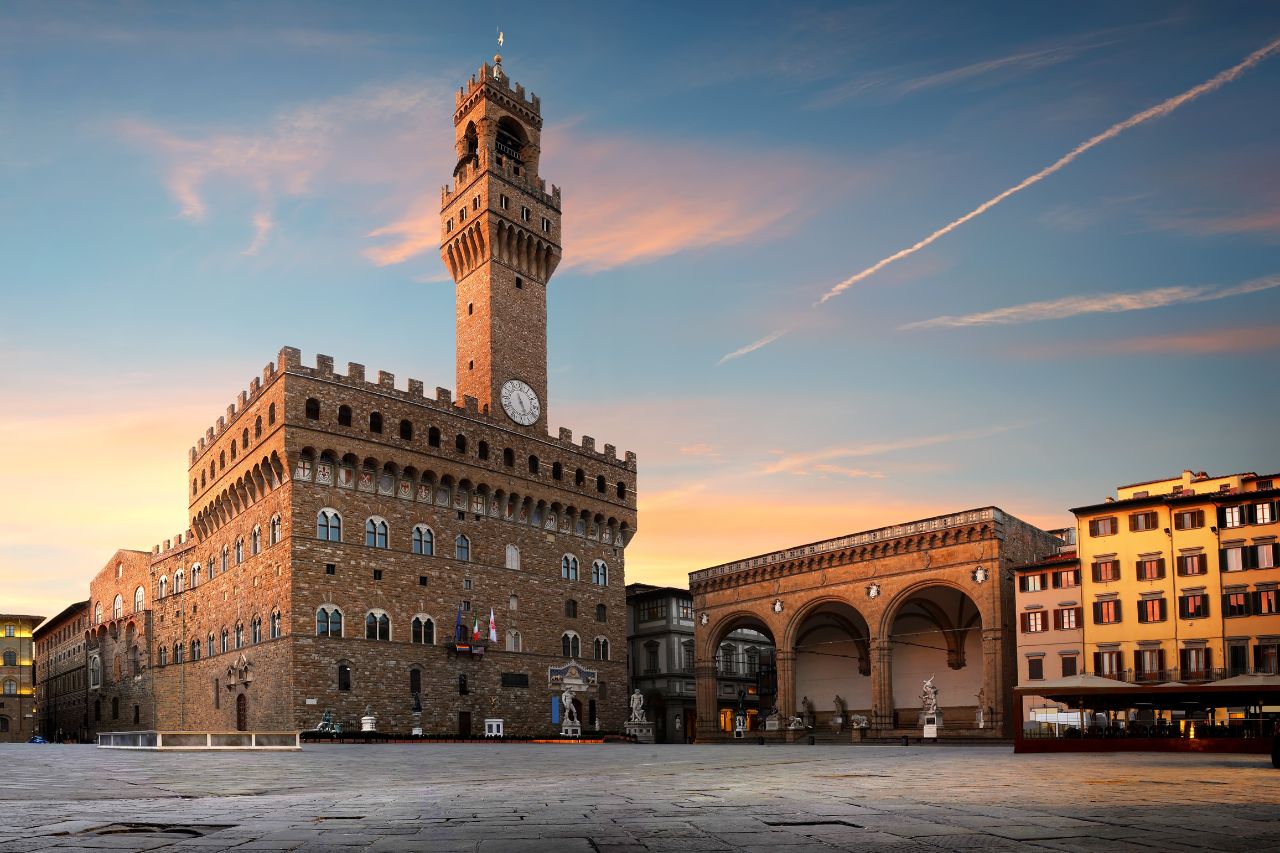
Palazzo Vecchio is a cornerstone of history and art, originally serving as the town hall and now housing the mayor’s office. Constructed in the 14th century, its iconic tower and robust structure command the Piazza della Signoria, a testament to Florence’s rich political and artistic heritage. The interior is a treasure trove of Renaissance art, with opulent rooms like the Salone dei Cinquecento showcasing grand murals.
Visitors can explore its historical and artistic magnificence, including guided tours that unearth the palazzo’s secrets and the stories of influential figures who once roamed its halls. Offering more than just historical insights, the palazzo provides panoramic views of Florence from its tower, encapsulating the city’s enduring beauty.
22. Palazzo Farnese (Rome)
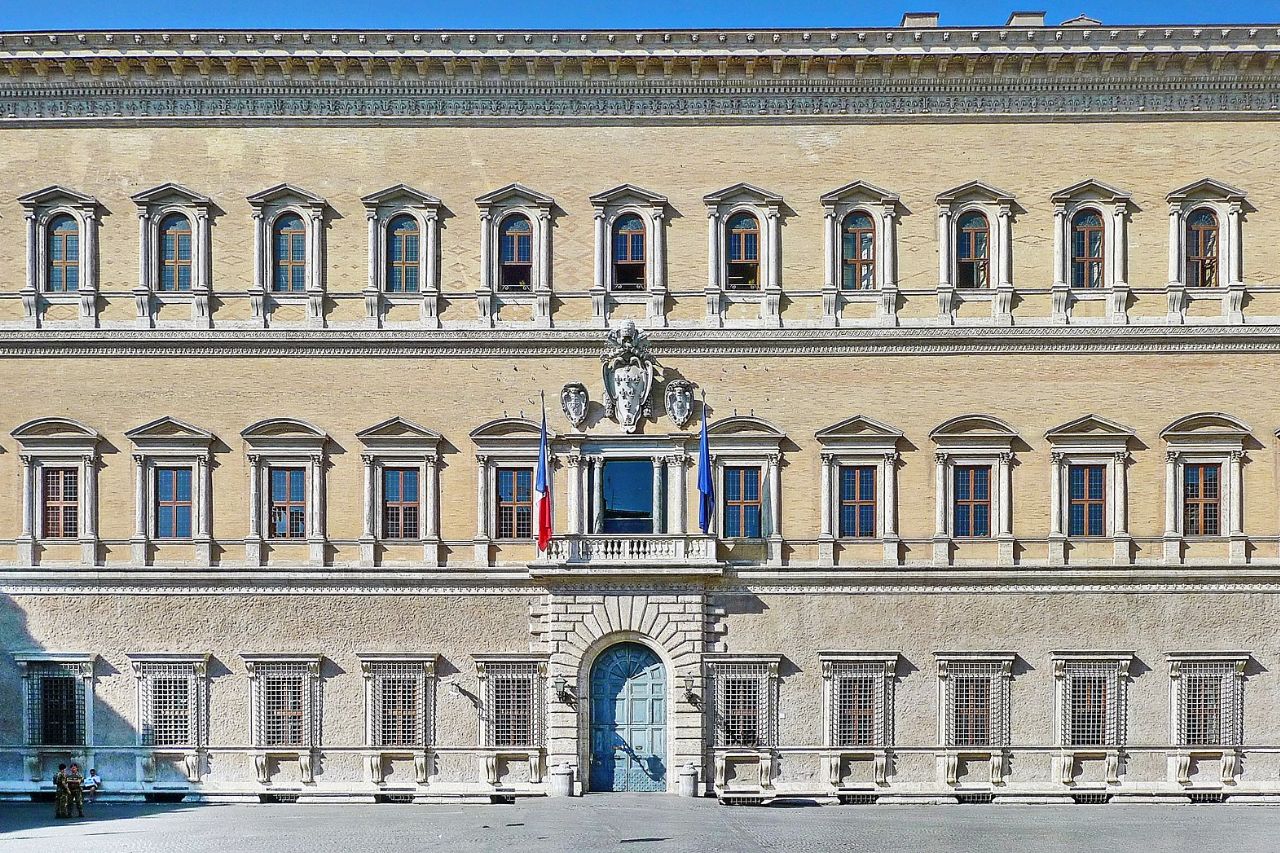
Palazzo Farnese, a jewel of the Italian Renaissance, stands proudly in the heart of Rome, reflecting the city’s opulent history and architectural grandeur. Commissioned in the 16th century by the Farnese family, this palatial masterpiece now hosts the French Embassy, symbolizing a blend of historical legacy and diplomatic prestige. Its façade, designed by Michelangelo, showcases the pinnacle of Renaissance artistry, inviting onlookers to marvel at its elegance and symmetry.
Inside, the palazzo is adorned with sumptuous artworks, including frescoes by Annibale Carracci, making it a haven for art enthusiasts. Beyond its aesthetic allure, Palazzo Farnese serves as a vibrant cultural venue, hosting exhibitions and events that bridge past and present. A visit here offers an immersive experience into Rome’s rich tapestry of history, art, and culture, encapsulated within the walls of one of its most magnificent edifices.
23. Palazzo della Pilotta (Parma)
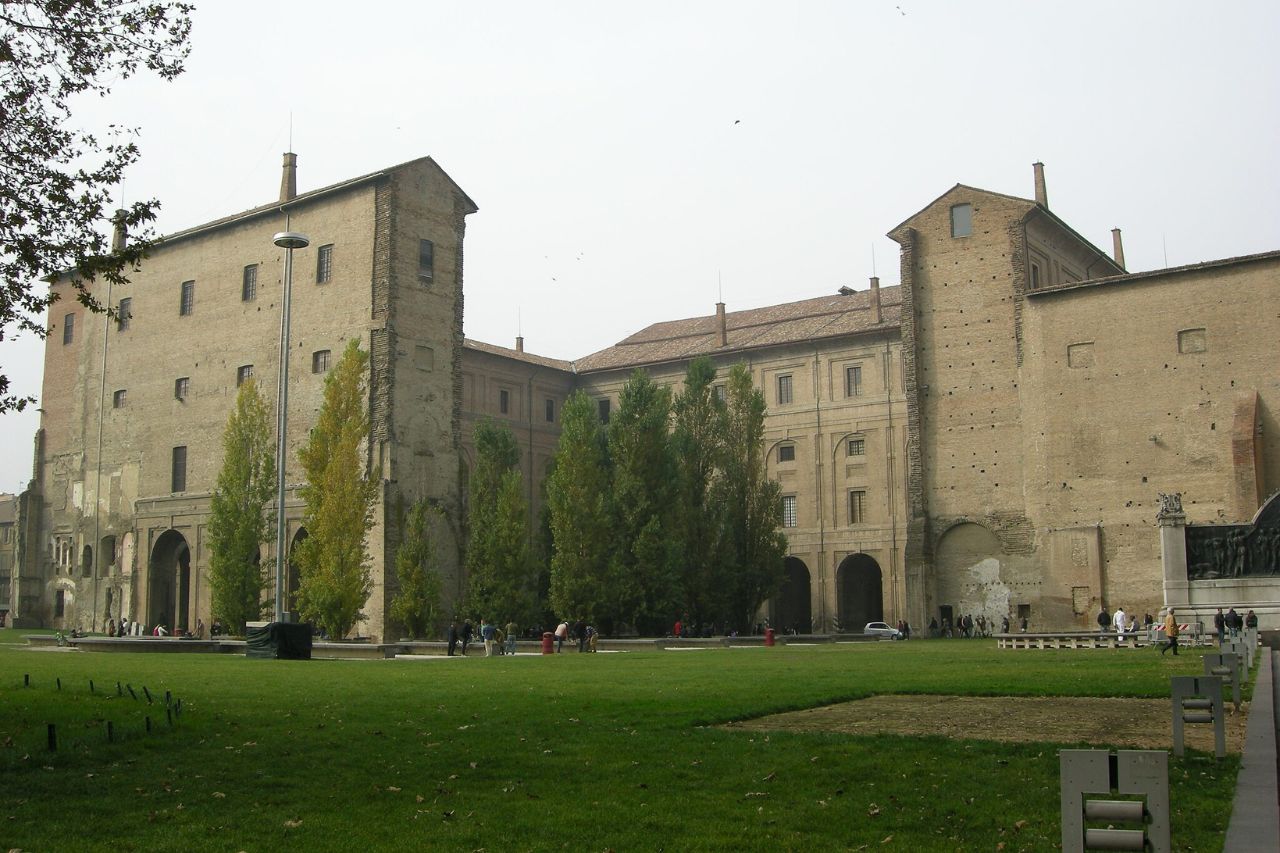
In the enchanting city of Parma, the Palazzo della Pilotta stands as a monumental testament to the city’s historical depth and cultural richness. Constructed in the 16th century, this architectural complex was initially intended for the Farnese family’s administrative and courtly needs. Over centuries, it has evolved into a hub of cultural activity, housing the Farnese Theater, the National Gallery, and the Archaeological Museum.
The Palazzo’s name, “Pilotta,” intriguingly derives from the game of pelota played by Spanish soldiers stationed there. Today, visitors are drawn to its impressive courtyards, majestic halls, and the stunning array of art and artifacts within its museums. Walking through the Palazzo della Pilotta, one embarks on a journey through time, where the splendor of the Renaissance meets the intellectual vibrancy of modern Parma, offering a unique insight into the city’s enduring legacy.
24. Palazzo Doria Pamphilj (Rome)
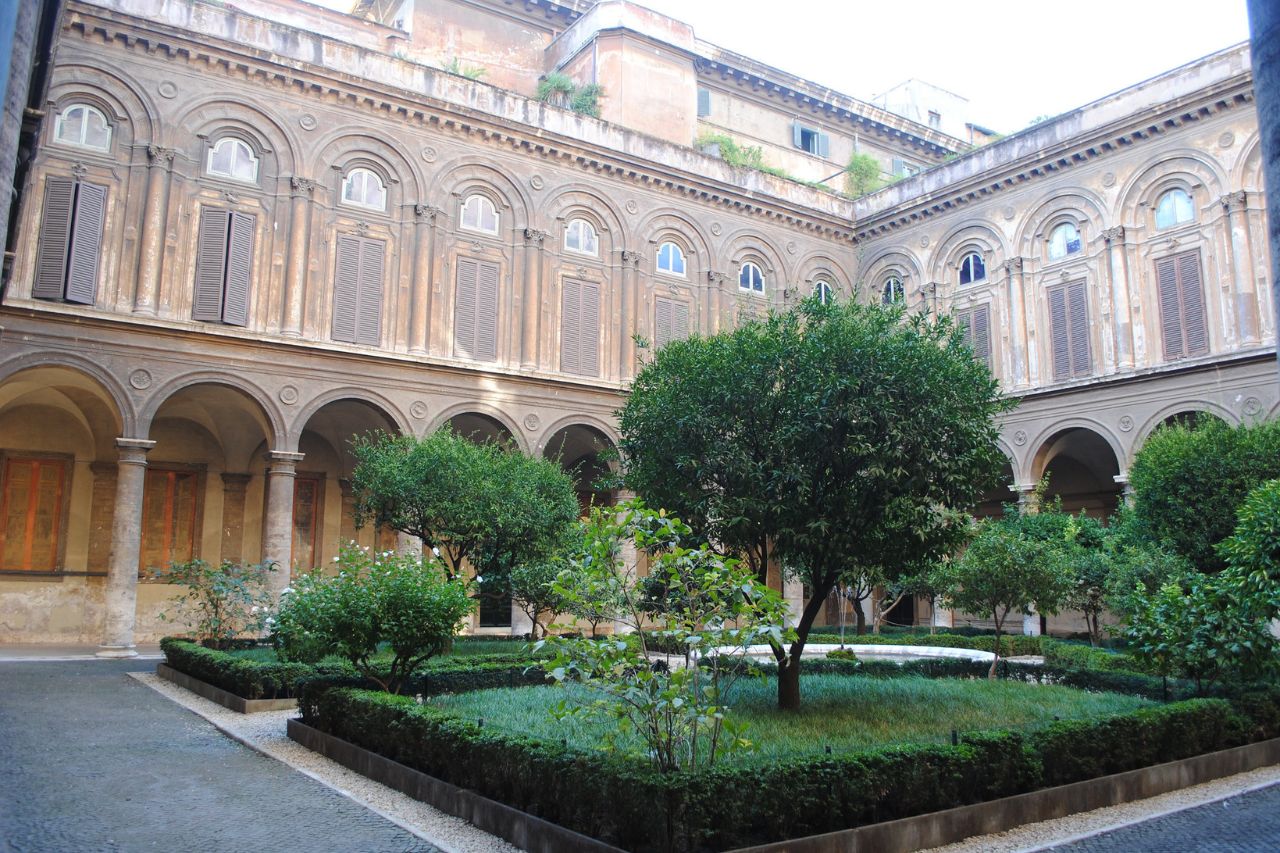
Palazzo Doria Pamphilj, positioned prominently on the vibrant Via del Corso in Rome, stands as a testament to the grandeur of Italian nobility and art. This magnificent 15th-century palace, still owned by the Doria Pamphilj family, hosts an impressive art gallery filled with centuries of Italian artistic achievement. The collection features masterpieces by Caravaggio, Raphael, and Velázquez, including the iconic portrait of Pope Innocent X by Velázquez, a highlight of the gallery.
The palace’s lavish interiors, adorned with intricate decorations and grand halls, offer a deep dive into the opulent lifestyle of Roman aristocracy. Visiting Palazzo Doria Pamphilj offers more than an art exhibit; it’s a journey through Rome’s rich artistic and noble history, providing a unique window into the past.
25. Villa Medici (Rome)
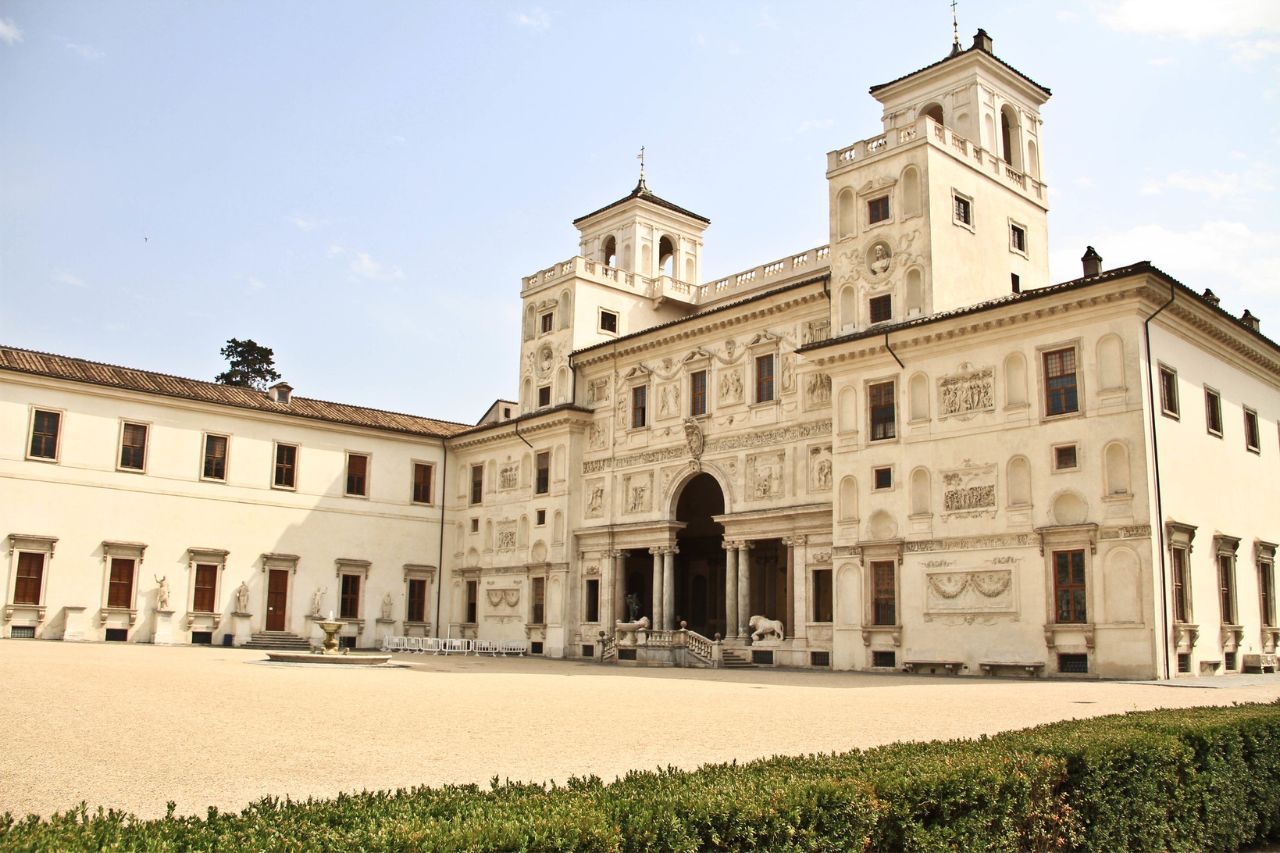
Villa Medici, located atop the Pincian Hill in Rome, is a stunning showcase of Renaissance architecture and sprawling gardens, offering panoramic views of the Eternal City. Founded by the Medici family in the 16th century, this historical villa has been a center for art and culture, currently housing the French Academy in Rome.
Its gardens, adorned with sculptures and fountains, provide a serene escape from the city’s bustle. Inside, the villa is rich with history, featuring art collections and exhibitions that tell stories of its past residents and their influence on art and culture. A visit to Villa Medici is not just about admiring its beauty and art; it’s about experiencing a piece of history that continues to inspire and influence the cultural landscape of Rome.
26. Palazzo della Ragione (Padua)
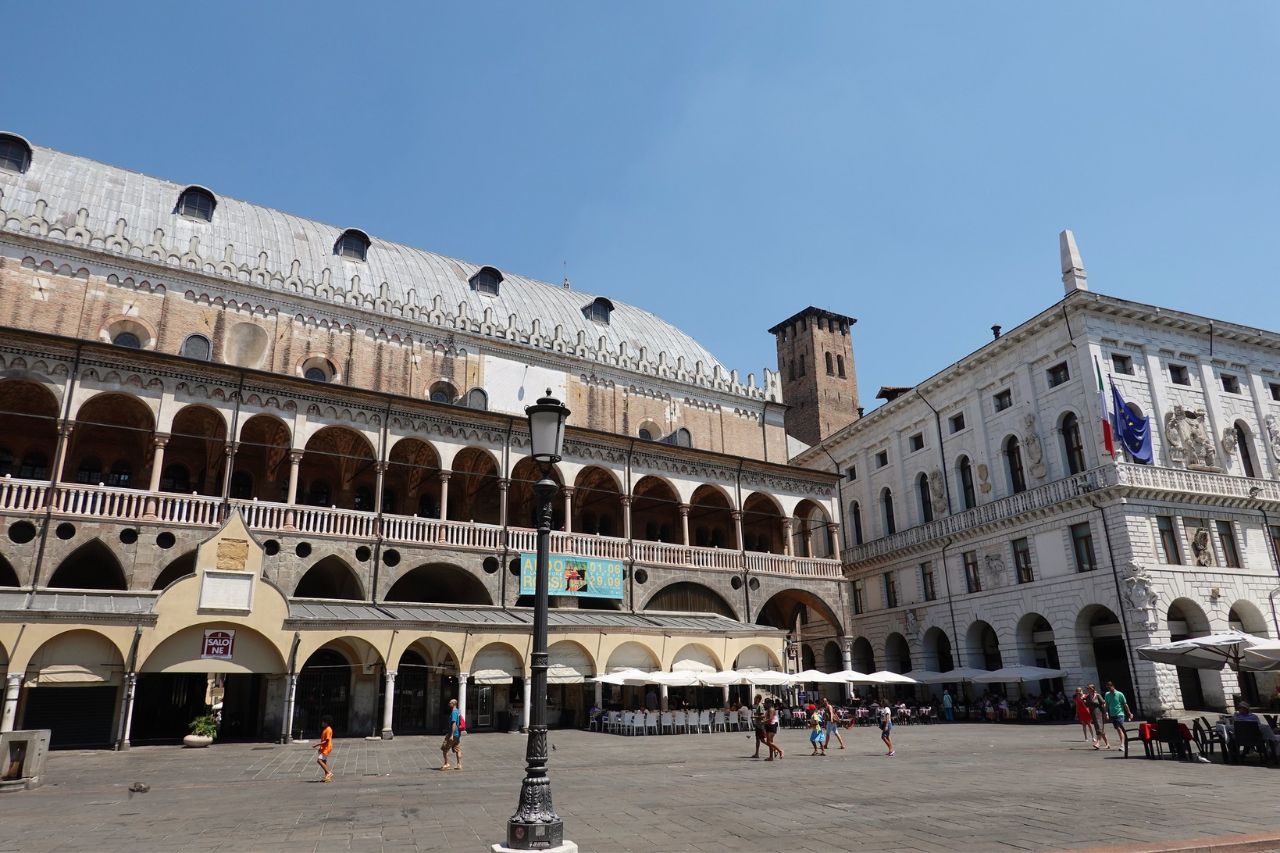
Palazzo della Ragione in Padua is a striking example of medieval civic architecture, serving as the city’s law court for centuries. Erected in the 12th century and later expanded, it features a vast hall, one of the largest medieval halls in the world, known for its magnificent wooden roof structure. The walls are adorned with a fascinating cycle of frescoes that depict astrological themes, providing insight into the medieval mind and the era’s blend of science, art, and philosophy.
Today, it stands as a vibrant cultural space, hosting exhibitions and events that breathe new life into its historic walls. A visit to Palazzo della Ragione offers a unique opportunity to walk through history, marvel at architectural and artistic marvels, and engage with Padua’s rich cultural heritage.
27. Palazzo dei Priori (Perugia)

Palazzo dei Priori in Perugia is a symbol of the city’s historical and political significance, dating back to the 13th century. This grand structure serves as a testament to Perugia’s rich medieval past, housing the town hall and the National Gallery of Umbria. Its façade is adorned with symbols of the city’s power and artistic heritage, including the majestic Griffin of Perugia. Inside, visitors can explore a series of rooms filled with masterpieces of Umbrian art, reflecting the evolution of Italian art styles through centuries.
The palazzo’s Gothic architecture, intricate frescoes, and valuable artworks offer a deep dive into the cultural and political heart of Perugia. A visit to Palazzo dei Priori is not merely a step back in time; it’s an immersive experience into the enduring legacy of one of Italy’s most historically rich cities.
28. Palazzo dei Conservatori (Rome)
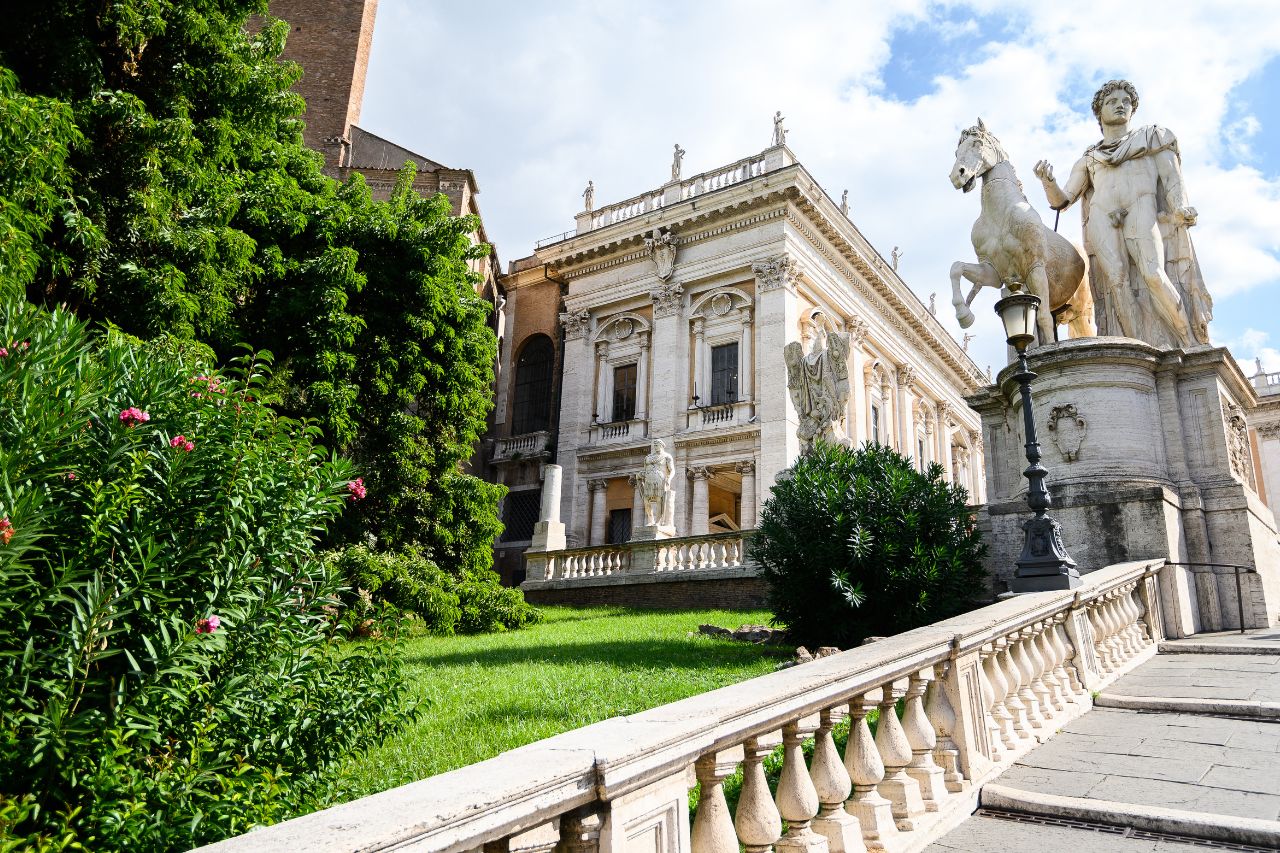
Palazzo dei Conservatori, located on the iconic Capitoline Hill in Rome, is a cornerstone of the city’s cultural and political history. Originally part of a medieval complex designed by Michelangelo, this building now forms part of the Capitoline Museums. Its halls and galleries are filled with ancient Roman statues, inscriptions, and artifacts that tell the story of Rome’s glorious past.
The palazzo itself, with its stunning architecture and design, reflects the Renaissance era’s influence on the city. Highlights include the original statue of Marcus Aurelius on horseback and the breathtaking frescoes that line the walls of the grand halls. Visitors to Palazzo dei Conservatori are treated to a journey through time, where the splendors of ancient and Renaissance Rome are vividly brought to life. This experience is not just an exploration of history and art; it’s an intimate encounter with the enduring soul of Rome.
29. Palazzo Magnani (Bologna)
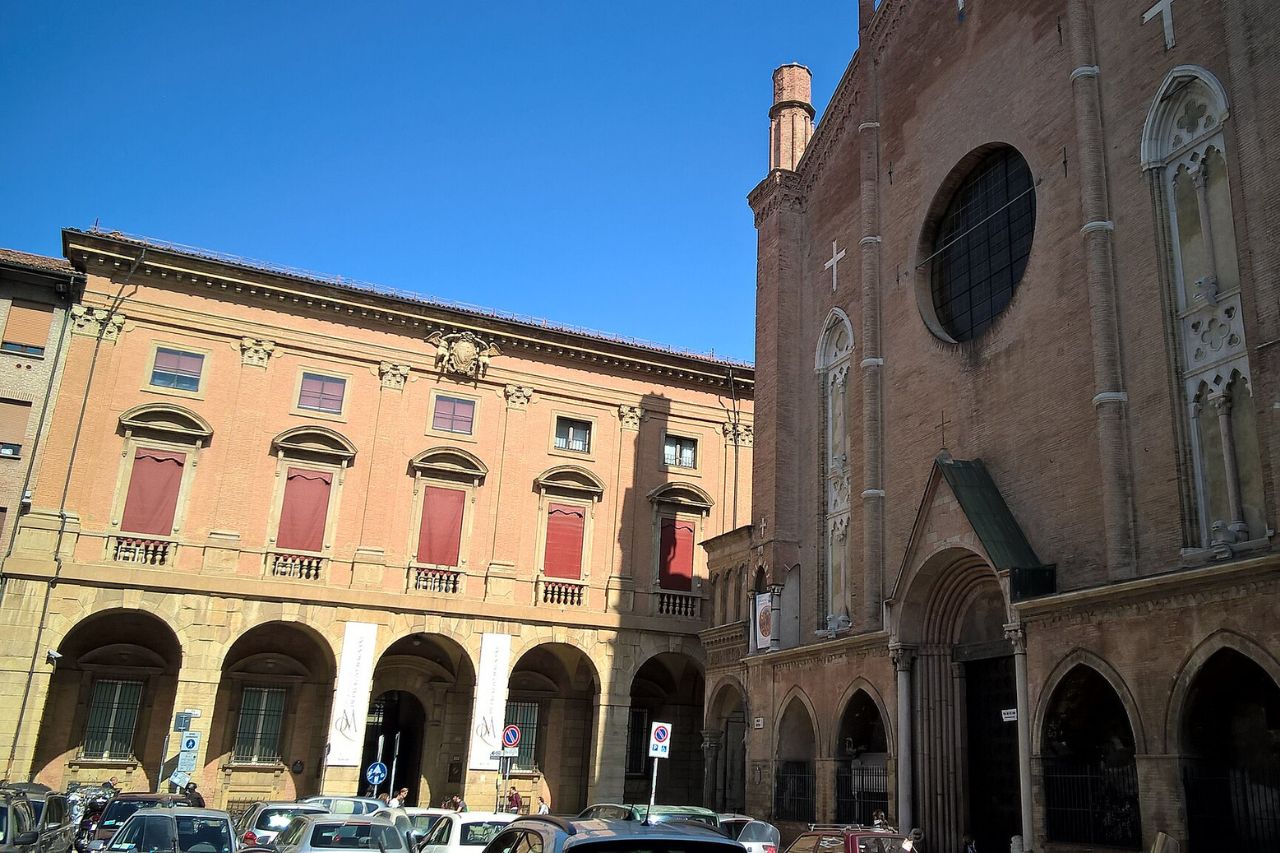
Palazzo Magnani, in the heart of Bologna, is a masterpiece of Renaissance architecture that captivates visitors with its elegance and historical depth. Built in the 16th century for a prominent local family, this palazzo is renowned for its exquisite façade, adorned with detailed frescoes that illustrate the artistic brilliance of the period.
Now, it hosts a cultural foundation and serves as a venue for prestigious art exhibitions, drawing art lovers and historians alike. Inside, the palazzo’s rooms are a testament to the luxury and sophistication of the era, with each space offering a unique insight into the life and times of its former inhabitants. Palazzo Magnani is not just a building; it’s a portal to the past, offering a glimpse into the rich cultural tapestry of Bologna and the enduring legacy of the Renaissance in Italy.
30. Palacio Colonna (Roma)
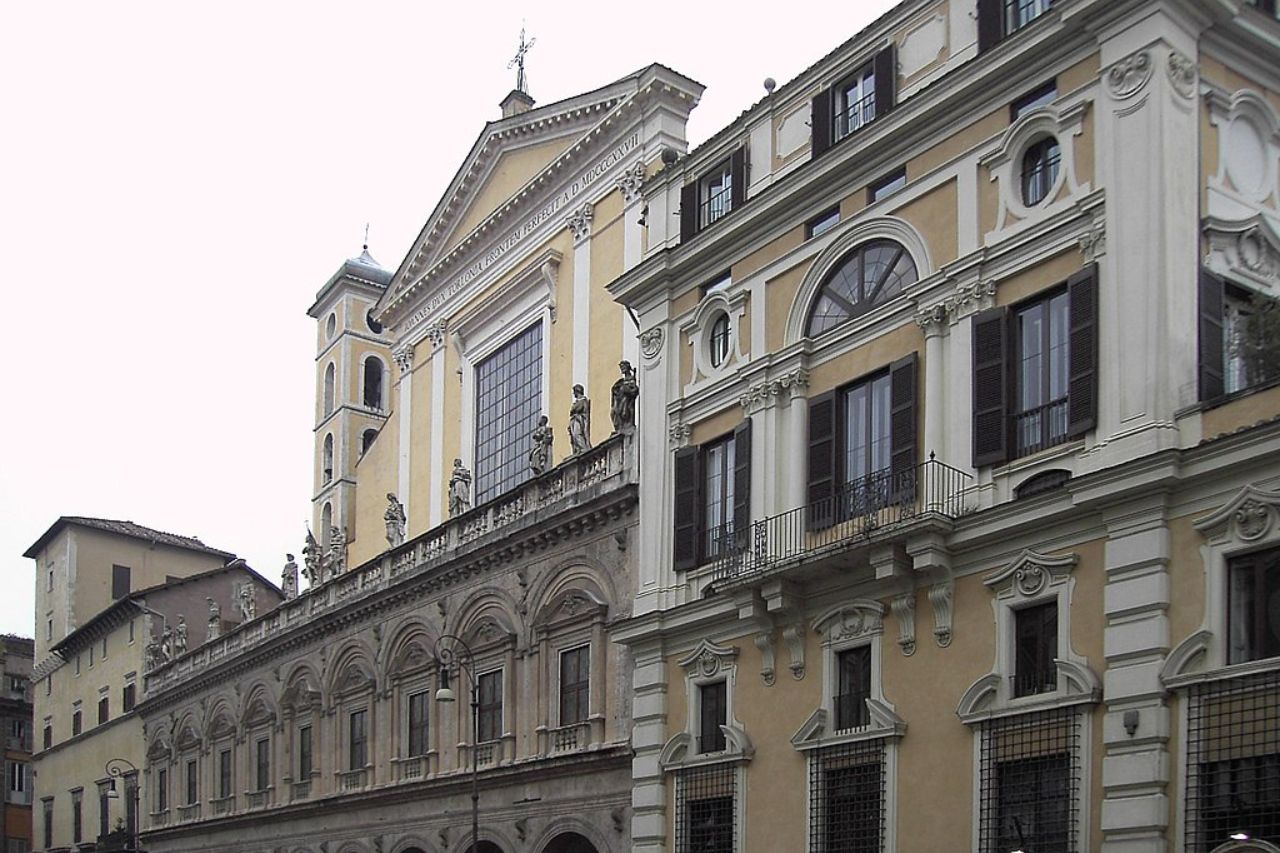
Palazzo Colonna, one of Rome’s most ancient and architecturally significant palaces, has stood as a beacon of aristocratic grandeur for centuries. Nestled in the heart of the city, this magnificent palace dates back to the 14th century, showcasing the evolution of Roman architecture and art through the ages. The Colonna family, one of Italy’s most storied noble families, has owned it throughout its history, imbuing the palace with a deep sense of heritage and tradition.
Today, Palazzo Colonna is celebrated for its breathtaking Gallery (Galleria Colonna), which houses an impressive collection of art, including works by leading artists of the Baroque period. The opulent interiors, adorned with gold leaf, frescoes, and marble, exemplify the wealth and power of the Roman aristocracy. A visit to Palazzo Colonna offers a unique glimpse into the lavish lifestyle of Rome’s noble past, making it a must-see for anyone interested in the history and art of the Eternal City.
Characteristics of Italian Palaces
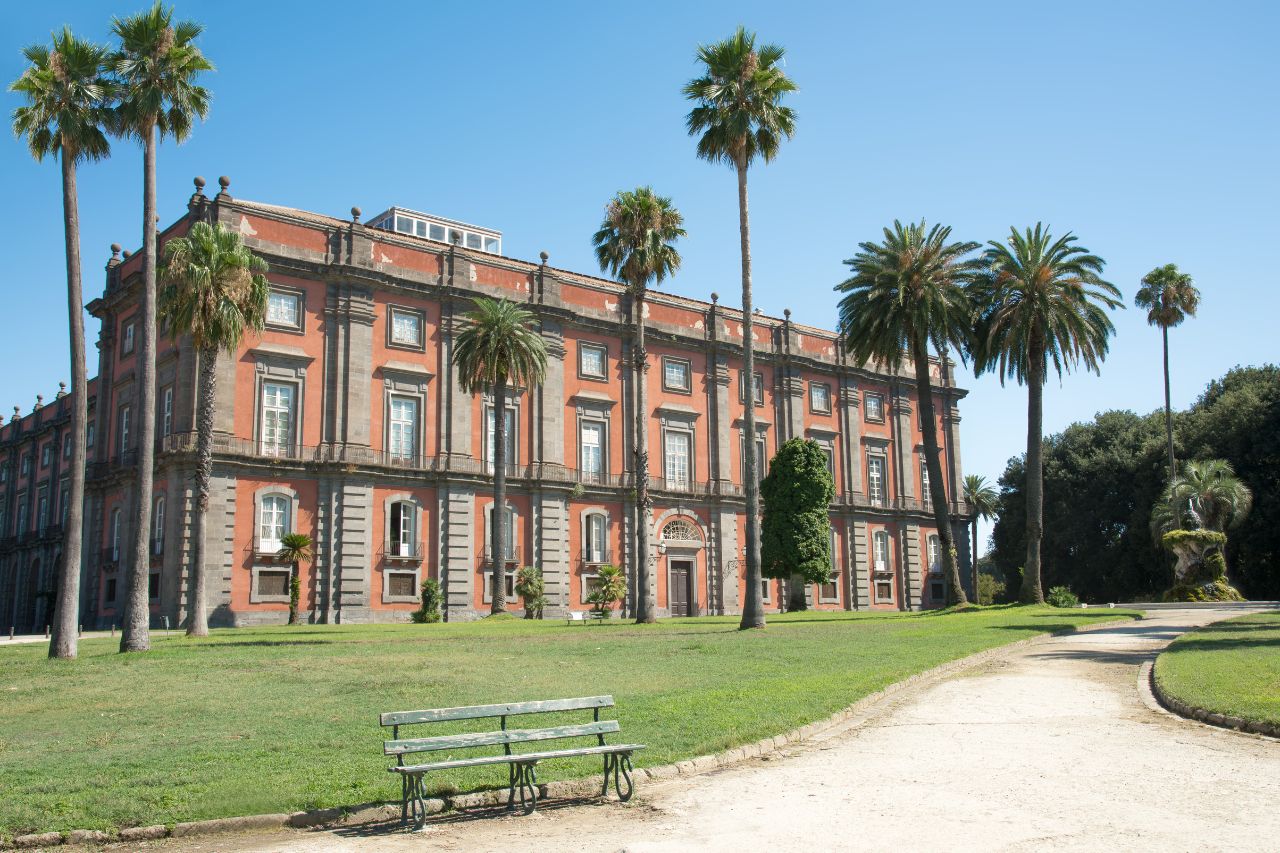
One of the main characteristics of an Italian palace, or palazzo, is its exterior, which might reflect influences from either the Renaissance, Romanesque, or Italian Gothic periods. Some of the more well-known and recognizable palaces can be seen along the Grand Canal in Venice and in Florence.
UNESCO World Heritage Site
The United Nations Educational, Scientific and Cultural Organization (UNESCO) is responsible for identifying places of importance to cultural heritage, and that is why so many Italian palaces have been named UNESCO World Heritage sites or are in cities that carry that same distinction.
Medieval Architecture
Palaces are very typical of the late Italian Medieval period of architecture. This style is known for its large walls, small windows, tall towers, and rolls of arches. Examples include the the Bigallo in Florence, Palazzo Pubblico in Siena, and Palazzo dei Priori in Volterra.
Renaissance Style
Italian palaces were built for wealthy families during the Italian Renaissance, so it’s understandable that this time period would have an important influence on the style. They rose to popularity in the 19th and 20th centuries and typically have symmetrical, corniced, basemented, and neat rows of windows.
See also: Medici Books: The Best Books to Explore the Renaissance Tuscany
FAQs About the Italian Palaces
Here are the most frequently asked questions by travellers:
What are the Largest Italian Palaces?
The Royal Palace of Caserta is the largest, but others include the Palazzo Colonna in Rome, Palazzina di Caccia di Stupinigi in Turin, Palazzo dei Normanni in Palermo, and more.
What is the Italian Version of Versailles?
The Royal Palace of Caserta is known as the Italian version of Versailles. In fact, it is the largest former royal residence in the world,coming in at nearly two million square meters. It was built by the Bourbon-Two Sicilies family to serve as their primary dwelling.
How Many Royal Palaces are There in Italy?
According to Wikipedia, there are approximately 300 royal palaces in Italy; however, it is hard to know the exact number due to how many have been lost over time. Make sure to visit these historical time capsules if you have the opportunity.
Conclusion
Exploring these grand palaces of Italy offers a unique journey through the country’s rich tapestry of history, art, and culture. Each palazzo, with its distinctive architecture, priceless artworks, and storied past, tells a part of Italy’s complex narrative. From the regal Palazzo Vecchio in Florence to the ancient splendor of Palazzo Colonna in Rome, visitors are invited to step back in time and immerse themselves in the beauty and grandeur of Italian heritage. These palaces are not just monuments of stone and mortar; they are living museums, vibrant cultural centers that continue to inspire and captivate the imagination of all who walk their hallowed halls.


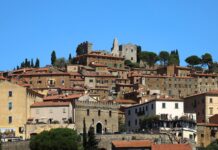
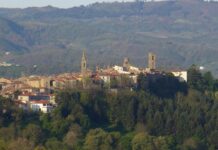
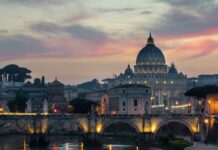




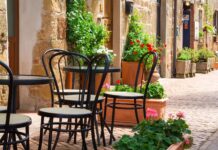

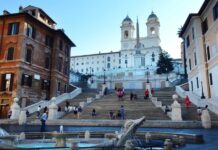


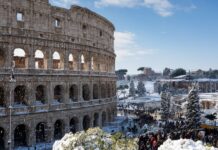
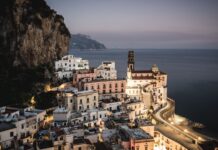
![Italian-Palaces[1] Italian Palaces](https://italytravelsecrets.com/wp-content/uploads/2023/09/Italian-Palaces1-1068x542.jpg)
